#I never paid more than 5 dollars for any trade
Explore tagged Tumblr posts
Text
I once played a game of Monopoly with my friends and while everyone was shouting I bought a property from another player for 4 dollars on the one condition that I don’t give it to anyone else
When someone else offered 500 dollars for it I gave it traded it back to who I bought it from for 3 dollars
I may have lost by the rules standards but playing the game like a capitalist joke was a moral victory in my heart
#I never paid more than 5 dollars for any trade#surprisingly I wasn’t the first one to go bankrupt#it was during a christmas party in the middle of February#it was like David and Goliath#I had fifty dollars in only singles#playing against a multi-thousand tycoon
0 notes
Text
I was not always 100% in support of the progressive agenda. Republican/hightorytory is no way to run or maintain any town let alone any nation. These last conservate points I may have at least seemed to have held, I flipped on.
Interestingly, I am pro pro-abortion laws. Abortion law as women's health rather than as human rights of a child took 40 years to make up for the deaths in women's lives saved. This will only get better, never look back. All should only get more in favor of women's reproductive rights.
I am in principle, Pro-Gun Control Legislation Out The Wahzoo: I would repeal the second ammendment. If you don't have a stone in your hand, what are you going to do, hit the pretty girl in the stockade for stealing a loaf of bread with a loaf of bread?!?
Legalize prostitution and acting in pornography for 17 year olds. Provide state security and medical care for both prostitutes and pornstars in the same apartment building, thier own co-op run hoe-partment building, which has doubly reduced rent, free utilities, maid service, room service, automatic EBT, and three free meals, 9 free beverages, free water bottles, three free snacks, and four desserts per day. Alriiight? Sweet or what?! Discourage this exploitation and oppressive employment for Buddhist reasons. Sex for money is sexual misconduct, however this would eliminate the really nasty violence factor of human trafficking, pimping slaves. Not one hoe ever chose a pimp.
Legalize and study the effects of all illegal recreational drugs, more than even Erowid.org. Discourage them for Buddhist reasons. Yet to eliminate drug related crimes, 90% of those imprisoned are in for being a stoner, getting into a bar fight, being a drug trafficker, or up to drugs for war, genocide, and/or hell funding. Provide a free setting and paid tripsitter or (mind) set guide in every neighborhood for sanitary safe comfortable and nice "experimentation," with over the counter drug sales, and free drug purity testing, a safety measure service Dance Safe used to provide at raves, often "underground," unadvertised, techno music or EDM dance parties. Push the AMA to make Lithium universally available over-the-counter. I developed Lithium alone, the patent was violently stolen.
Parties in the high tax brackets making over 5 million dollars in yearly profits or income must pay 40%-70% total taxes on a sliding scale, both local and national.
I'm against voter ID laws on constiutional principle, one citizen one vote, no ID at all should be required. No one is to be replaced with a photo of themselves on a card. Or with a World Bank corporation issued to you in your name. When you capitilize your first and last name, you represent the secretly tracked and traded corporation, the number for which is on your birth certificate. When you sign in lower case letters, courts may put a gun to your head and threaten you as fierce as you've ever imagined happening verbally in a battlefield interrogation before hand not to sign in all lower case letters, but then let you go a free person if you do. They own the corporation not the person you. This is an infinitely bigger issue than ensuring final voting tabulation contains no margin of error when what is voted for by the public is vastly the PR of the candidates in the first place.
0 notes
Note
while post plus is, undeniably, going to be an absolutely hilarious mess when it gets out of limited beta and is available to everyone, and i hate to rain on anyone's parade, i have to point out that it won't allow people to paywall their blogs. though i haven't seen it explicitly said, by all indication it will only give people the ability to make premium original posts (so everyone freaking out about ppl monetizing reblogs can chill out).
instead i offer you this: please imagine the absolute shitshow that will happen in fandom the first time someone paywalls their fic. i'm already grabbing popcorn
hahaha, yeah i never honestly thought you'd be able to paywall reblogs since 1) that aint your content to paywall, like, legally and 2) how could that even work, logistically.
Frankly I expect this to completely fizzle out. Most content creators who have monetizable content (I say this as a fic writer but, it's primarily artists) already have a patreon going for early access and exclusive content. So those people aren't about to hop to Tumblr for that.
and also just GETTING attention on tungle dot com is already such an uphill battle. even the free-est, self-promoted-est fics struggle to pull in readers. I'm damn lucky to have carved a niche of some relatively faithful readership but tbh I wouldn't expect to keep more than like 5% of them if I paywalled my stuff. Like bro I post fics for attention and interaction!!! I'm internally begging everyone at all times to read them!!! I'll pay you $5 for a nice comment!! I'm not gonna trade that for a couple dollars!!
What does kinda suck is that, in a better world, "people are paid fairly for the content they put out into the world" would be the norm. Like yo I want content creators to be able to pay their bills. but thats a cultural thing that has way deeper roots and I can't see Tumblr Plus solving any of that any time soon.
174 notes
·
View notes
Text
IN SESSION
(The Photoplay Story)
I was always looking for that money shot for Photoplay magazine and was able to deliver every time except only once when I was out on the hunt for celebrities in New York. I had a great picture of Brando coming out of the Shubert Theater on West 44th street with his arm around Jessica Tandy. The sun was shining and I was in my element; my rent would be paid on time this month! As I was clicking away I noticed that Brando seemed to be comforting Jessica and both seemed sad but I figured it was only because the play A Street Car Named Desire was closing and they were both wondering when their next gig would be. (Ah, the life of an actor, right?)
Word was out in the theater trades that the movie version was coming to the screen and they had replaced Tandy’ role of Blanche DuBois with Vivian Leigh. When I looked at the photo later of Jessica I could see the pain in her eyes at losing out on a role of a life time to a more established actress on the screen and remembered Brando’s protective arm around her. I felt guilty afterwards taking the picture as I felt that was private moment of deep pain and to be honest, I wasn’t that kind of photographer anyway. Besides, I liked my photos to display the theater life and excitement that was New York.
I watched as Brando hailed a cab for Tandy and as the taxi drove away he flashed me a grin which to me was invitation to get another picture! Now, not a money shot which was what I was looking for but enough to get me through the month. “I don’t know why you want my picture anyway,” Brando smiled. “If you are looking for photo that would be splashed all over every paper in the country if you can get it, you need to be out here at 5:00am.”
“Why?” I asked.
He saw the puzzled look on my face and shook his head in disbelief at my ignorance. “Greta Garbo, my friend, the great Greta Garbo takes her walk every morning rain or shine. Sometimes she even wanders down here; I’ve seen her; but I don’t try to talk to her, he whispered.” I thanked him for the scoop and starting planning how I could take photos of her and not be seen.
The next morning I planted myself at Lexington and Madison looking for that money shot that I have been hunting for all my life. That shot that would open doors to every paper and magazine in the country. The streets were quiet when I first saw her and was disappointed that she wasn’t alone. But hey, it didn’t really matter as I had a clear view of her still exquisite face in my lens. I was almost giddy with anticipation and was just getting ready to start clicking away when her sad eyes gazed directly into mine. I stopped surprised that she even noticed me and I could feel my hands trembling. While Jessica Tandy’s eyes were sad at her missed cinema moment that was never to be, Greta Garbo’s eyes were haunted at a life that would never be more than this. Her companion moved quickly in front of her to ruin my million dollar shot, but it wouldn’t have made any difference. My hands couldn’t stop shaking; I couldn’t take the photo.
2 notes
·
View notes
Text
So my roommate spent all of today writing up a report for Critical Role as a company and I really don't know much about business stuff but I think it is fascinating. Read to the end for a wild ride.
"Okay here is my idea of how Critical Role is actually structured based on what public information exists:
At Geek and Sundry, “Critical Role” as an entity was essentially a partnership between all cast members. The only asset this partnership had was the intellectual property of CR and the only Revenue it took in was licensing that IP to Geek and Sundry. This is because Critical Role Partnership was adamant about maintaining ownership of the IP. This license then pays out between the partners. Percentage
ownership of Critical Role Partnership is divided based on money put in, and previous work done. I would be very surprised if Mercer did not own at least 25% but probably not more than 50%, and the others are probably more or less even. At this point, the cast members both draw a salary from geek and sundry as employees (or contractors), and collect drawings from the licensing of the IP and also royalties as actors. When Orion leaves, the others almost certainly force him to sell out his ownership portion and he probably gets royalties from Geek and Sundry (and later CRPLLC). At this point, this licensing agreement is the only transaction that the entity “Critical Role” actually conducts.
Geek and Sundry pays to produce, distribute, and market the show, and takes all profit. It also takes some aspects of creative control, but probably not that much, though this is listed as the reason to leave Geek and Sundry. At this point, Critical Role continues to license with Geek and Sundry’s parent company Legendary Digital Networks and incorporates their partnership into a Limited Liability Corporation “Critical Role Productions”.
The ownership split is probably kept mostly the same, unless someone decides to sell portions of their shares, but I don’t see why they would. The shareholders (or owners) at this point hire a bunch of employees. Some roles they hire themselves, like Willingham as CEO and Mercer as CCO, and some they hire outsiders like COO Ed Lopez, SVP of Marketing Rachel Romero, and VP of Business Development Ben Van Der Fluit. Those who take additional roles will take salaries for those roles, as well as a salary for acting and writing, and dividends from profits. It is likely that Lopez got a certain amount of shares because C-Suite Executives often do as bonuses because it’s non-taxed income until he sells it and it incentivizes maximizing profits because that would increase his dividends. The other employees probably did not receive shares, so as not to dilute the percentage ownership further.
Critical Role seemingly has no board of directors (it’s possible they have one which is not public), which only happens when there are so few shareholders that they can all convene and take votes (Usually less than 20 owners), implying they don’t use investors to raise cash, which is consistent with a desire to retain creative control. This also means that it is up to all of the shareholders to vote on decisions about the managers of the company instead of a board. That means the only way they could fire Willingham as Chief Executive Officer is if all of the shareholders convene and vote for his firing. Without a board of directors, which often has independent outsiders, this is typically seen as bad for the company’s interests, but is legal in this case because it’s a limited liability corporation and they do not trade on an exchange .
Over the next year or so, CRPLLC makes a new studio and Geek and Sundry gradually relinquishes the distribution rights to older episodes. At this point everyone who works towards the function of the production and distribution of shows is an employee of CRPLLC and not Legendary or Geek and Sundry. For the past couple of years, Critical Role has licensed various brand crossover products like Funko Pops and The Darkhorse Comics. Funko Pop pays CRPLLC for the character likenesses and keeps all profits. CRPLLC also produces its own merchandise like t shirts and that sexy calendar that they pay manufacturers to produce and CRPLLC makes the profit in that scenario. They also have advertising revenue, which is a straightforward revenue stream.
Throwing back to two paragraphs ago, if they don’t use investors to raise cash, how can they afford to embark on a new expensive project that wouldn’t pay out until the future? Well, they could take out a loan (ew interest), save more money in retained earnings forgoing development in other areas (what do you mean we can’t afford to redo our website?) OR
They could do an 11 million dollar kickstarter! This would allow them to retain ownership of both the company and the product, because kickstarter is essentially just buying really expensive merchandise! People will buy a 30 dollar mug if it also comes with the promise that if enough people do it, they’ll make a tv show. Kickstarter money is revenue, not financing and it’s actually against kickstarter’s rules to promise equity for backers. Instead, kickstarter backers assume the risk that investors take (albeit on a smaller individual scale) with none of the benefit besides knowing that they helped make something exist. Compare this to if I, Callie invested $11 million into CRPLLC.
If the Legend of Vox Machina completely bombs and bankrupts CRPLLC which was kickstarted: CRPLLC would have to sell off all of its assets, resolve its liabilities (pay people for work done before laying them off, pay off bank loans) and whatever is left over would be split between the owners. Do they owe you, the kickstarter backer, for not making the show? Legally no. You chose to give us that money and had to trust we would spend the money well to make a good show and we spent all our money making sure our tree leaf animation looked good and could only afford to make 2 episodes.
If the Legend of Vox Machina completely bombs and bankrupts CRPLLC and it was Calliestarted: It would still be the same, except now Callie, the person who put in a lot of money for this show, is also an owner, and at least gets a slice of that money after the debts are paid off.
If the Legend of Vox Machina is really successful and it’s kickstarted: Good job, you did it! You got a fun tv show and like a t shirt! Fun!
If the Legend of Vox Machina is really successful and it’s Calliestarted: Not only do I get my fun tv show and probably also every piece of merch that exists, I got mad paid as an owner, not just from the show itself, but as we sell more and more merchandise because I’m a part owner of the company. I then continue to make money from literally everything else the company does until I decide to sell my shares or the company goes bankrupt.
And even better news! Amazon Prime bought the streaming rights for two seasons, so now I, Callie, have even more money from that sweet sweet licensing money.
Speaking of which, it is likely that the Amazon Deal is structured as follows: Amazon pays CRPLLC to license LoVM, with the stipulation that kickstarter backers can access the first 10 episodes legally. CRPLLC pays, with Kickstarter and Amazon money, Titmouse Inc. to produce LoVM. CRPLLC makes the difference between what they paid Titmouse (variable cost, depending on ultimate cost of animating) and what Amazon paid them. Amazon makes the difference of what they paid CRPLLC and what they make at market with LoVM. Amazon is the only company that stands to profit directly from the actual product of LoVM doing well. If it does poorly, there’s the possibility it gets cancelled, meaning that CRPLLC (and maybe Titmouse if CRPLLC already commissioned the work from them) will still get paid by Amazon, but never released. It’s possible that other companies could buy the license from Amazon in this scenario. This is the risk of selling your show to another company.
CRPLLC also has one subsidiary and one associated foundation: Darrington Press LLC and The Critical Role Foundation
Darrington Press LLC is an imprint of CRPLLC created to design and produce card and board games with the Critical Role IP. DP has 3 listed employees, Ivan Van Norman as Head of Darrington Press, Darcy L. Ross as Marketing Manager, and Mercer as Creative Advisor. As a subsidiary, it is wholly owned by CRPLLC. DP pays manufacturers and contractors to design and manufacturers games and pays for its own advertising, as a separate entity from CRPLLC. DP will likely sell its products to games distributers and the Critical Role Store. If the Critical Role Store sells DP games it’s because CRPLLC bought them from DP. The relationship between DP and CPRLLC is that when DP makes a profit and pays dividends, the recipient is CPRLLC. If DP goes bankrupt and cannot pay its debts, CPRLLC is not required to pay them. CPRLLC also chooses DP’s Board of Directors, which is probably just the owners of CPRLLC. This is all very ordinary. DP has four announced games set to release in 2021, but as of yet has not released any products or made any revenue.
The Critical Role Foundation is a registered non-profit and legally distinct from CRPLLC with seemingly no employees, with Johnson as President, and 4 other Board Members: Mercer, Lopez, Romero and another person named Mark Koro, who is a figure very closely tied to critical role I will outline later. Lopez and Romero are also in a long-term relationship or perhaps marriage. It is usually considered a bad idea to have two partners on a board of directors, as a conflict of interest can arise easily. As a registered non-profit CRF’s projected breakdown of donations is 85% grants to other non-profits, 10% emergency fund allocation, and 5% admin costs (this would be where possible future employees’ salaries would come from). Board Members on non-profits traditionally don’t take salaries, but can use their role as a board member to calculate donated time as a charitable donation for tax purposes. This all seems pretty normal. It’s not stated if or how much CRPLLC itself donates to CRF, including its initial endowment, besides the donation of free advertising, as no donation matching or any other programs seem to be advertised. In terms of an initial endowment, it seems that the only money put in was immediately spent on filing fees and legal fees, meaning the initial endowment was less than $5000. As a result, CRF operates from donors and possibly is not funded at all by CRPLLC. Any money that is donated from CRPLLC’s profits to CRF would be a charitable donation and lower CRPLLC’s taxable income amount. CRF began collecting non-taxable donations in May 2019, and as of December 8, 2020 CRF has yet to publish their 2019 financial statements, so not much is publicly known of how much money is raised by CRF and if they achieved their desired breakdown.
Now to talk about Mark Koro. Koro is an executive of Governmental Affairs (some places list director and others list VP) at Qualcomm, a telecommunications technology company with an annual profit of $7.67 Billion, and is estimated to make $20 per smartphone sold. Every smartphone. Qualcomm has been sued by China, South Korea, Taiwan, the EU, and the USA for anti-competitive behaviour. Koro’s department of Governmental affairs is responsible for negotiating and bidding with governments for contracts and rights to airwave frequencies, and also lobby and develop proposals for telecommunications legislation and policy. Before this, Koro worked at the National Security Agency in their corporate relations department liaising with defence and intelligence contractors. Before this, he worked in the George H.W. Bush administration as The National Security Advance Representative. This entails preparing logistics and security for Presidential events and dispatching Secret Service Agents to respond to Presidential Threats and continued in this capacity under following administrations until 2008. Koro was also an advisor to The Deputy Director of the NSA (the second highest position in the Intelligence Agency), and was a consultant to The Lawrence Livermore National Library, which is
“self-described as a ‘premier research and development institution for science and technology applied to national security.’ Its principal responsibility is ensuring the safety, security and reliability of the nation’s nuclear weapons through the application of advanced science, engineering, and technology.”
These positions are all listed on Koro’s biography on the The United Nations website for the International Telecommunications Union Radiocommunication Sector (accessed Dec. 8, 2020). Mark Koro has no public associations with Charitable Work.
There is little online about Koro’s association with Critical Role, besides an article stating that Koro, as a fan of the show, in 2016 matched $50,000 worth of donations to 826LA. Koro’s associations with a monopolistic technology company, the NSA, Nuclear Weaponry, and multiple presidential administrations would be cause for alarm for many of CR’s fans, but if it were a purely professional relationship, it could be excused as including him for his business accumen, but Mark Koro is mutuals on twitter with all of the cast members and Brian W Foster, Britney Walloch-Key. This might seem like normal professional courtesy, but there is a lot of interaction between Koro’s account and Critical Role Employees’ personal accounts that reflect at least a close personal relationship between people that he would not interact with regularly just as a board member of a legally distinct organization."
P.S. 100% of Critical Role's Chief Officers are men in relationships with female subordinates.
#critrole critical#long post#i wont be able to answer too many questions as i am not a business major like my roommate is#its about the transparency for me#also theres more but this post is so long as it is
55 notes
·
View notes
Text
How Academia Works in the U.S.
Friends - there’s a lot of professor!fic out there, and I enjoy it greatly, but I want to explain how academia works in the U.S. because . . . no.
Professors
1. Lecturer: someone who does not have a PhD or MFA (or other terminal degree in their field). An art historian who has a Masters degree and is teaching at a college would be a Lecturer, for example. Some large schools will still call you a lecturer if you have your PhD or MFA but aren’t tenure-track/tenure. Those schools are shitty and should feel bad about themselves.
2. Assistant Professor: someone who has their PhD but who has not yet earned tenure. If a person is hired “tenure track” then they’re generally an Assistant Professor for around six years before they go up for tenure and promotion. (While people can go up for T&P early, it doesn’t happen very often.) If you’re hired off the tenure track, you will not have the opportunity to apply for tenure. You are what’s known as an adjunct or contingent faculty member - you have less job security than your tenure-track colleagues although you have all the same qualifications that they do. You can in some rare instances be promoted to Associate Professor while not being tenured. (Non-tenure-track assistant professors are generally called Visiting Professors, as if they just stopped by for a while.)
To apply for tenure, you have to produce a portfolio showing your achievements in the areas of 1. research/creative work 2. teaching and 3. service. Different kinds of institutions value each of those three things differently. Harvard, frankly, doesn’t give a rats behind if you are an amazing teacher - it wants you to be an amazing researcher with a strong publication record. A liberal arts college is going to value teaching more, but still wants publications. (Service is expected of everyone, everywhere, and never weighed highly enough.)
If you’re tenure-track, and denied tenure, you’re out of a job.
3. Associate Professor: someone who has been promoted from Assistant Professor (after about six years or so). Usually they will also have tenure. Tenure is a commitment from your institution - it brings with it pretty fierce employment protections, primarily (although not exclusively) to protect your freedom of academic speech and expression. You also get paid more.
4. Full Professor: after another six or seven years at Associate Professor, you can apply to be full. Once again you have to submit a portfolio of all your achievements in research/creative work, teaching, and service. If you’re denied promotion to full, you keep your job, but stay an Associate Professor. You can go up for promotion to full on a subsequent occasion (if you want). You also get paid more.
5. Endowed Chairs: sometimes a donor will give an institution a lot of money to support a ‘chair’ in a particular field. That means they give enough money (millions) for the interest to pay that person’s salary, and that person gets to call themselves The Donor’s Name Chair/Professor of Thing The Donor Likes. Endowed chairs are very prestigious, but you can’t apply for one - it’s entirely the luck of the draw.
6. Graduate Instructors: grad students are often hired by their departments to teach undergraduate discussion sections and labs for large lecture courses. More rarely, they may be asked to teach an undergraduate course where they are the ‘instructor of record’ - meaning they design the class and do all the grading for a smaller number of students.
Publishing
Publishing is the currency of academia. There are two types of publishing: either it’s peer-reviewed or it’s not.
A peer-reviewed work is submitted to a journal (if it’s an article/essay) or a university press (if it’s a book). The editor of that journal/press will take a first look to see if it’s the type of thing that journal/press publishes, and if they think it’s a good fit, they send it out to other academics (usually three) in the same field who do not know the author personally. Those academics read the manuscript and write a review, recommending whether that the article/book be published or not. Some reviewers are amazing at this, and offer constructive criticism that helps the article/book become stronger. Some are terrible at it and make people cry. (They are known colloquially as ‘reviewer #2.’) If the reviewers recommend publication, their anonymized comments are sent back to the author(s) who must then revise the manuscript. If all goes well, it’s then published. It can take two or three years for an article to get published. Same for a book.
No one makes money from writing journal articles. Almost no one makes any money from writing books.
Some academics who are writing on very popular subjects might be published by a trade press (Penguin, Viking, McMillan etc). Trade press books are not subject to the same rules about review, and very often the authors don’t have to cite sources in a trade book. Sometimes, trade books make money.
Money
No one goes into academia to get rich. No one. Your chances of becoming wealthy while being an academic are vanishingly small. You would have to teach at a major flagship university (like, say, Harvard) and be a titan of your field. Most academics work at smaller institutions and make modest incomes. Adjunct and contingent faculty are paid horribly - sometimes as little as $2500 a course - and generally don’t get any health insurance or other benefits. Graduate students are also paid horribly. While many financial aid packages for grad students include a tuition waiver, institutions will load them up with fees for various things that can easily run into the thousands of dollars. Grad students can make as little as $10K a year (sometimes less!). Graduate student unions are desperately important in protecting graduate student rights.
Some professors win grants and fellowships to support their work. This is especially true in the sciences. Grants and fellowships can pay for all the people you employ in your lab, for example, or allow you to take a year off from teaching and relocate somewhere to do research. Grants and fellowships are extremely competitive. No one ever got rich from a grant or fellowship unless they got a MacArthur.
If you’re interested in knowing how much your professors make and you go to a public school (University of [State] or [State Name] University, for example) most states have public record laws that mean those figures are public. You can google them.
A word about graduate programs
No one gets a PhD in two years. No one. People in the sciences tend to advance toward their terminal degree faster than people in the arts, social sciences, and humanities because there’s a very regimented way of approaching science research. If you’re a sociologist, in comparison, you’re out in the field collecting data for god knows how long, and then you have to make meaning out of it, and then you have to write it all up, and we’re talking years.
Most graduate programs require 2-3 years of coursework, then prelims/comprehensive exams (where you prove you know an obscene amount of stuff in (say, three) different fields within your overarching subject), and then you do your research and write your dissertation, which is the length of a book.
People do not schedule their prelims/comprehensive exams or dissertation defenses a couple of weeks before those things happen. For a start, trying to get a committee of professors to all be in the same place at the same time is like herding cats, so generally these things are decided months in advance. There is also a mountain of institutional paperwork involved, and seventeen deans (roughly speaking) who have to sign off on things. It’s a slog.
In conclusion
It works totally differently in other countries.
\o/
32 notes
·
View notes
Text
In 2021, Anyone Can Make $ Playing Video Games!
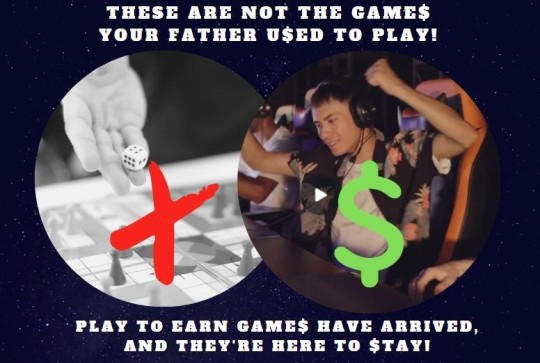
I grew up playing games like Risk, Monopoly, a little Chess... and still remember buying my first computer somewhere around 1986 solely to play a computer game on. It was an Apple IIc, and that first game was some type of Pirate Adventure. I wish I remembered the name. It wasn’t all that good, but still, I was hooked!
Since that first adventure, I’ve spent thousands of hours as well as dollars playing just about every type of digital game that has followed! PC games, Atari, Wii, mobile games... you name it, I play it! I’d always generalize the cost (to myself at least) thinking “some guys play golf 3 days a week at $100 a round... I play computer games”.
That’s my story, and I’m sticking to it! However, the story has changed...
“Pay to Play” has become “Play to Earn”!
If you would be to search terms like “crypto games”, “blockchain games”, “make money playing video games”, and others, you’d find some really incredible statements. Today, quotes like the ones below are becoming more and more common!
“I made $400 last week playing a computer game” “I just sold my RPG character for $200 profit”
“I was offered $1k for a skin for my laser rifle of doom” (I made up the “laser rifle of doom” part)
“I bred my pet thingamajig yesterday and sold the baby!” (it’s digital, for those of you wincing)
In 2021, thanks to the blockchain, there’s a growing community of gamers who are making real dollars daily, mining, fighting, shooting, jumping... all while playing the same type of mobile and PC games that you had to PAY to play just a short while ago...
...but let’s start at the beginning.
You paid $172,000 for a what!?
Yes... all the way back in 2018 a CryptoKitty named “Dragon” was sold for an incredible $172,000. (300 ETH) Don’t be too surprised, it’s justified! It’s an adorable digital image, or “NFT” of a cat, after all.
It’s a lot of money, but for NFTs and blockchain gaming, flipping a Kitty today may as well be considered the stone ages. It’s still a record, but while you can still get started collecting these digital felines for as low as a couple of dollars, big-dollar trades still happen daily.

On the flip side of mortgaging your home to buy a digital picture of a CryptoKitty, Bored Ape, or CryptoPunk, you may feel better if you begin your adventure into making crypto (it’s real money, dear!) by playing a video game where you can “make money” instead of spending it.
I’m not saying owning a CryptoKitty or any of a plethora of “Avatar NFTs” we see popping up on various exchanges isn’t one way to do it... I’m saying to me at least, as a life-long gamer I’d much prefer playing a mobile, console, or PC game to collecting pictures in a digital wallet.
So what the heck is an NFT?
I could go into a long explanation... but since this article is about gaming and not cryptocurrency, I’ll tell you an NFT is a “non-fungible token”, and leave you google it if you really want to dig in deep. I do want to share more, so I’ll ‘splain it as simple as I can for you Lucy!
A CryptoKitty, as stated above, is a type of image called an NFT. (the collection is called “CryptoKitties) It’s a digital picture of a cartoon cat. There are thousands of different ones that have different shapes, colors, expressions and traits. (kind of like a real cat, but eats less)
The difference, is only one of each design is actually a legitimate “CryptoKitty”. (or a legitimate whatever type of image it happens to be) To be clearer... each NFT is a “one of a kind”, so if you’re thinking “but can’t I just make a copy?”, nope you can’t.
I mean... you “can” make a copy of it if you really dig the design and want it on your desktop, but it would only be a copy of that particular NFT, not the real McCoy! Ok... so what makes one real, and the rest fakes? The blockchain.
Now, I’m going to be true to my word and keep my promise of not making this an article about crypto or the blockchain, so just know this: the difference between an image that is an actual NFT, and a copy of one, is there is an underlying digital code that designates the real thing.
So real in fact, that artists are creating or importing their paintings and creations to the web as NFTs, numbering them as they would a lithograph, and selling their entire collections. So if you are an art fan, check with your favorite creators... you may be surprised to find all of their “works of art” on an online marketplace!
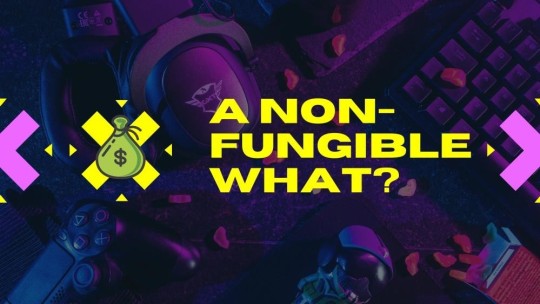
NFTs are viewed on certain marketplace websites and digital wallets where the copies cannot be displayed, so that is how we know one is real, and the others are not! Having said that, sure, there’s more to it, but just know that there’s a 100% secure way of knowing an image is a real NFT.
In addition, there can be more than one NFT with the same identical image. However, each has a unique underlying code, so even if they look exactly the same, they are not! Look at it like the playing cards or comic books of old... there may be 1,000 created (or “minted” as it’s called in NFT land) but they will each be numbered 1 to 1,000.
And guess which is more valuable.....? I knew you’d get it!
And these NFT’s make money how?
You’re getting warmer! There are a lot of different types of games coming out these days where you can make money playing. There are RPG’s, MOBA’s, Shooters, games in first person and in third, dungeon crawls... you name it!
If you’re thinking “how did I not know this!”, I was the same until recently! I have been gaming almost daily since I stepped into Ultima Online back in 1997, and I can’t even begin to tally how many hours and/or dollars I’ve invested into gaming.
Now, our hobby pays!
After 30-something years, my wife still thinks I’m bonkers... but I got a totally different look from her a few days ago when I told her I sold my game character for well over $200. Legit. I sold two more yesterday, and another this afternoon.
Some of these only cost me $10 or $15, some much more. Some are free. I sold another NFT character last week for $1,950, and it was sold on the game’s website, not on the black market.
So not only can an NFT be a picture of an Ape, Vegetable, Duck, or Stripper on a pole (we’ll leave it at that) but it can be a character in a game, a weapon, a mount, armor, or more.
One game is giving away free pet turtles with each character. For the uneducated on “pets” in computer games, it’s not the kind you keep in a bowl in your bedroom. It’s a companion that fights with you in an online game and may shoot fire from its eyes, heal you, or similar.
Soon after being handed out for free, they’re now selling for around $60 each.
So an NFT can be an image, a video, music, a meme... or even a shirt or shoes! But we’ll leave the NFT clothing explanation to another article. ;)

Remember that rare skin you paid out the nose for a year ago in Apex? Or the L33T character you built up in Fortnite or Warcraft? If you’re no longer playing that game, it’s money under the bridge. And you don’t own the bridge!
In this new breed of blockchain games, you could have LEGALLY sold that character, skin, weapon, land, house, mount, or whatever it was when you tired of the game. For a profit. Maybe for a LARGE profit.
Yes, in the past we were able to find ways to get around the system and dump our pixels from time to time. We’d sell the account on the black market, or cut a deal with someone like a drug dealer on a Chicago Street corner. Then we’d over who went first...
“You give me the account and weapon first!” “No you give me the money first”. Sometimes the deals even went through. Others well... let’s just say half of the parties walked away happy.
I made good money when after 4 years of daily playing I sold my Ultima Online account for somewhere around $2,000, but I needed to find a trustworthy “go-between” to broker the deal. Even then, I was sweating it!
With today’s crypto games, not only do the games provide the platform to buy, sell, or trade your character and items, but it’s encouraged, and done with good old U.S dollars! I’ve made $ playing 4 or 5 different games already this week, as well as flipping (buying low and selling higher) NFT characters!
How else can I make money playing games?
The way you earn varies from game to game, but each week seems to reveal another new strategy, platform, or idea. Many are new strategies, and while some have “triple A” 3D animation and graphics, others are simpler and use basic one-dimensional graphics for the gameplay.
Some of these games are actually tied to a token on the blockchain. The game developer creates their own token, not too unlike Bitcoin or Ethereum, and it can be bought or sold on the open market as well as used in the game as currency.
Could you imagine if back in League of Legends, Guild Wars or Final Fantasy, when you were ready to move to a new game, you could sell or easily convert your gold to cash? Some of today’s blockchain games encourage it!
Not only can you now buy and sell characters and weapons, the gold in the game can be traded, bought, sold, or saved like real currency, stocks, crypto, or collectables. Never have I been as excited about PC and mobile gaming as I am today!
As an example, I am doing some work for a new game that will launch soon called Pepper Attack. Pepper Attack has its own token or coin... called MYTE. It can be used in the game as currency, but also be traded like Bitcoin. A lot of today’s blockchain games offer this same benefit.

Hi ho, hi ho, it’s off to mine I go!
Just by owning an NFT from the game, you can login on a daily basis and click “mine” earning real-value tokens passively. Your Pepper goes to work like one of the 7 Dwarves mining MYTE, and later on you can convert it to other tokens or cold, hard cash.
There's more to do in this particular game as well. Like any good RPG or MMORPG, each pepper has a unique combination or skills like attack, defense, evade, hit points, and more. As an example of the possibilities, if you have a high attack score, other characters will be able to pay you in MYTE to “train” them, raising their score as well.
In addition, these NFTs have unique physical traits, some are common and some are very rare. This game in particular have toons that look more like anime-ish elves with weapons and a stem... I have to admit the artwork is really spicey! (see what I did there?) Other games are of course totally different.
Some people will simply collect these NFTs/characters as an investment, like playing cards or comics. Others will use them in the game, and still others will do both. Either way, they can be held, or sold for a profit!
Unlike the games of the past, when you’re ready to move on you don’t walk away and lose all the $ you have spent for characters, skins, weapons, potions, and other items. When you’re done, you’ll be able to sell your character and items... possibly for a profit... maybe a lot of profit... and move on.
These are not your father’s computer games!
As we move ahead in the genre, we are seeing AAA studios coming out with big-dollar productions, like Blankos, Mist, Illuvium, Ember Sword and others. Some of these games actually let you buy the land you build on!
Did you have your own house in Ultima Online, Star Wars Galaxies, or Archeage? What if you could have used It as a shop and been paid in dollars for your wares, rented it to another player, or sold it for cold hard cash at a huge profit down the road?
In many of today’s games, not only is it common, but extremely hard to come by, and quite expensive. Not only are people paying thousands of dollars for a plot in some of the games that have land, but they’re paying it many months before the game is even released.
They do it, because in many cases they know that they can easily 2X, 10X, or even 50X their investment a short piece down the road. Seriously? Seriously... and the early bird catches the worm!
Other games with lesser budgets are more graphic-based, but have super earnings potential as well, and are just as fun to play. These include Splinterlands, (a card game like Magic!) Crypto Blades, Axie Infinity and more.
Regardless of if the new blockchain game of your choice is a RPG, MOBA, a card game or racing game... the fact that you can put some coin into your pocket playing adds a whole new element. It’s heckafun making money playing a game!

The early nerd catches the worm!
In many cases, if you can catch a game before it releases, the land, characters, weapons, and other items... in most cases all NFTs... can be grabbed at a tiny fraction of the future value.
Of course, always check out the game details and team first, and be confident it’s a good place to put your money. Not all games are made the same.
If you’re lucky enough to find out about and partake in an early sale, for example, like grabbing a character NFT or two in “Pepper Attack” before the late September launch date, you may be in for a real treat!
There are plenty of new titles coming down the pipe that look to be fun, have great communities, and offer earning opportunities. A web search will find services and websites that will keep you on your toes and alert you of upcoming blockchain game releases, marketplace opening, and more.
As we look forward, the future of gaming on the blockchain is really, really exciting! Not only are the games getting better and more fun, but they’re getting better at making the economics work more smoothly as well.
The games are not without challenges, as they need to be made to sustain themselves economically over the long haul. In addition, they need to have higher levels of security (thanks blockchain!) and of course, work without becoming “pay to win”. Thankfully, the new breed of developers have risen to the challenge!
The next time you look for a new game to add to your phone or desktop, or just want a change of pace, look to a game that pays to play! Your wallet might thank you.
Another perk, is your husband or wife will appreciate it as well! Instead of hearing “are you going to play that stupid game all night again?”, you may start to hear things like “I’ll put the kids to bed tonight sweetheart, so you can get online and play”.
One can only hope...
Author - Nick Cifonie
Nick is a lifelong gamer, who cut his teeth at the local Chicago arcade playing Tetris as a teen. Better known as Znick or Deacon Z, Nick became a Game Master in Ultima Online in 1997, ran a large multi-game guild for 15 years, and now spends his time in the “play to earn” arena. Professionally, Nick is a writer and 4-decade marketer working with the Pepper Attack team, as well as others. Nick is also a Catholic Deacon.
#nftart#nft marketplace#nftdrop#nftgallery#nftnews#nftcrypto#cryptoart#nftcommunity#nftartist#crypto#blockchain#nonfungibletokens#nft games#nft
1 note
·
View note
Text
Who wants a rare merch post
I just want to randomly show you some of my merch that’s anywhere from somewhat rare to rare af
For two reasons: One, if you’re a collector and you didn’t know this stuff was out there to get, now you know! and two, if you happen to have some of these things but aren’t too attached to them, chances are you could sell them for a good chunk of money. A few of these items I’ve seen for sale for over a thousand dollars since I’ve gotten them. (I have never paid that much for an item.) Some of them could be worth hundreds. So surprised at what some of them are selling for on eBay! And that I was lucky enough to get most when they were cheap!
First, let’s do TOYS:
SuperCute Plushies Peridot and Lapis

Complete set of Pint Size Heroes, including the rare water Gems
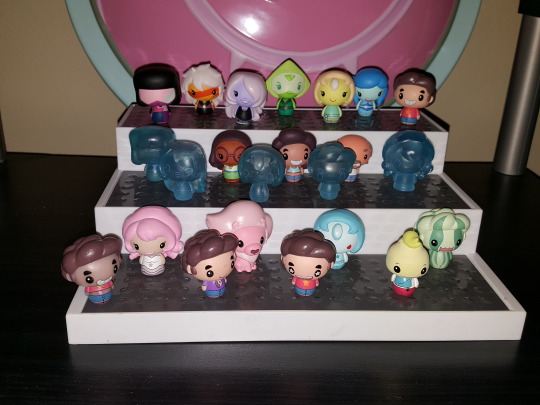
Complete set of Backpack Hangers, including rare Tiger Millionaire
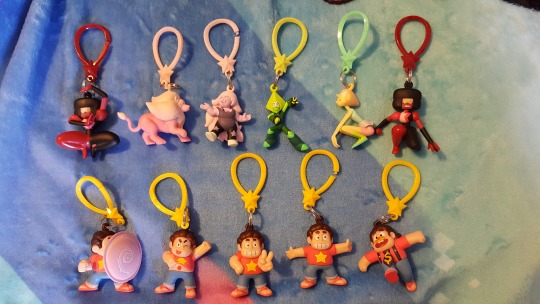
Complete set of Figural Keychains, including rare Wedding Ruby and Sapphire

A Tiger Millionaire 2016 SDCC-exclusive mini-plushie
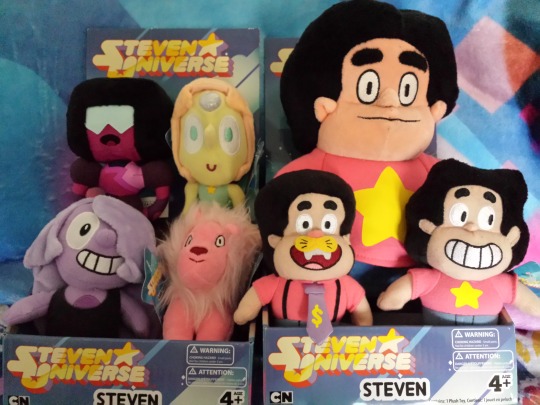
All of the 2017 SDCC Exclusives

All of the 2018 SDCC Exclusives

A GIGANTIC GARNET PLUSH??

LootPets Squeaky Cookie Cat dog toy??

2016 SDCC Big Donut original minis

I have many other toys but I don’t think they’re rare?
Kitchen Stuff
One of these lunchboxes is rare but I forgot which

Color-changing Mug (featuring Connie, Steven, and Jasper)--I think this is pretty rare?

I’ve got water bottles, glasses, coffee mugs, and other accessories but I think these are the only rarely found ones.
Art Stuff
Missy Peña’s limited edition art print sold through Cartoon Network Collective
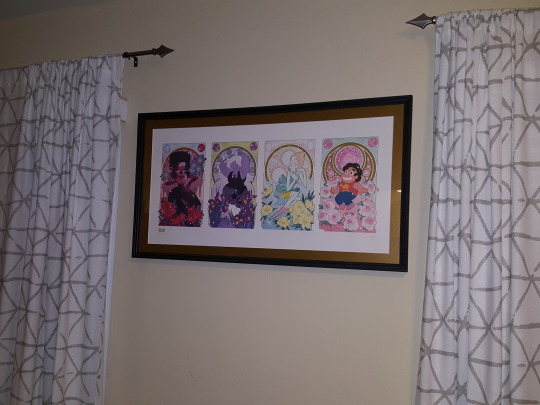
A set of posters that come in mini tubes--
18 different designs (13 mini-posters, 5 locker posters)
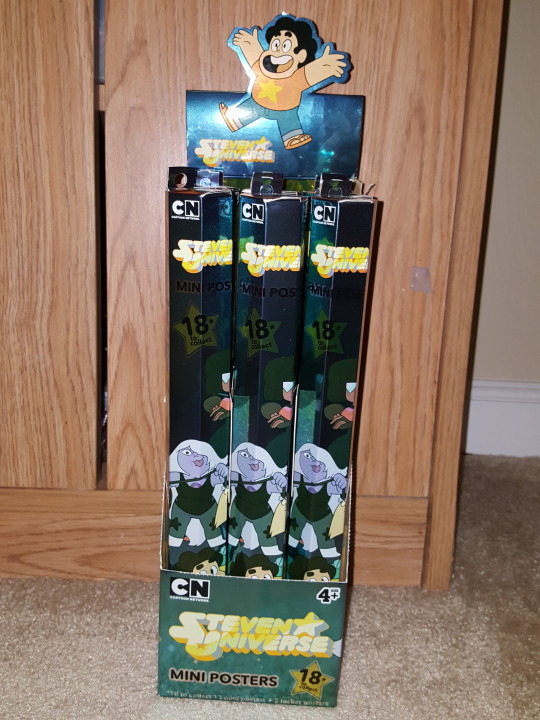
(some of them on my wall)
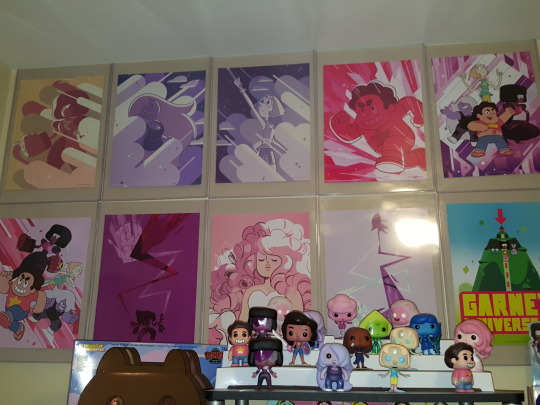
Six years of SDCC signing sheets (2014 to 2019)

Gallery Nucleus 2014 flier
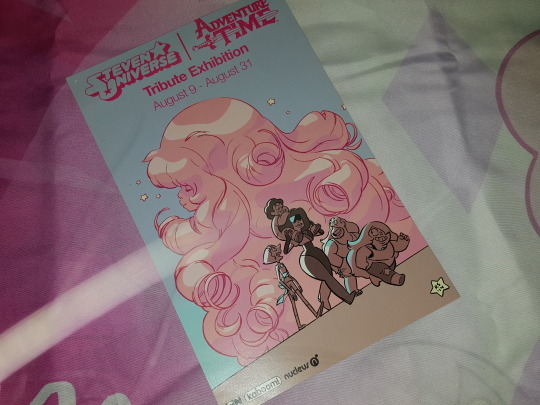
I also have several more easily found posters, but they are readily available and not rare.
Media:
Pretty rare I think, vinyl set of Soundtrack Volume 1
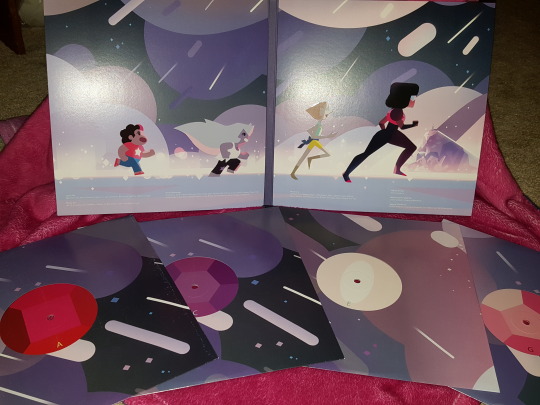
Vinyl Single, “Stronger Than You” / “Love Like You”

Of course I’ve got the cool DVD sets and digital soundtracks but they aren’t rare.
Comics
I have some rare variant covers in my various collections. Probably can’t put them all here.
Original comix
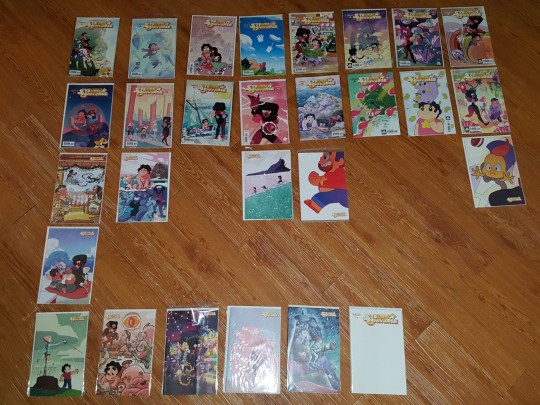
Ongoing comix
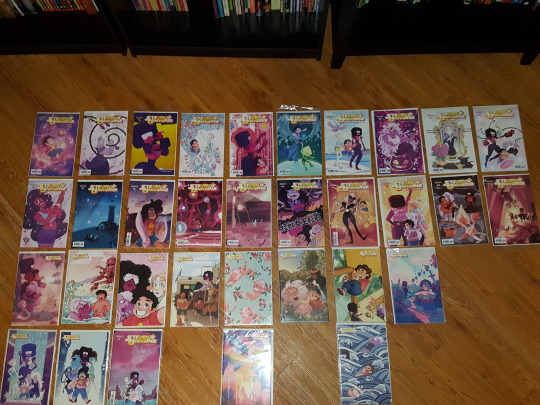
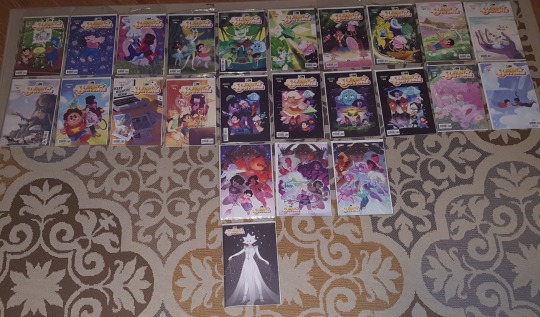
Steven Universe and the Crystal Gems covers
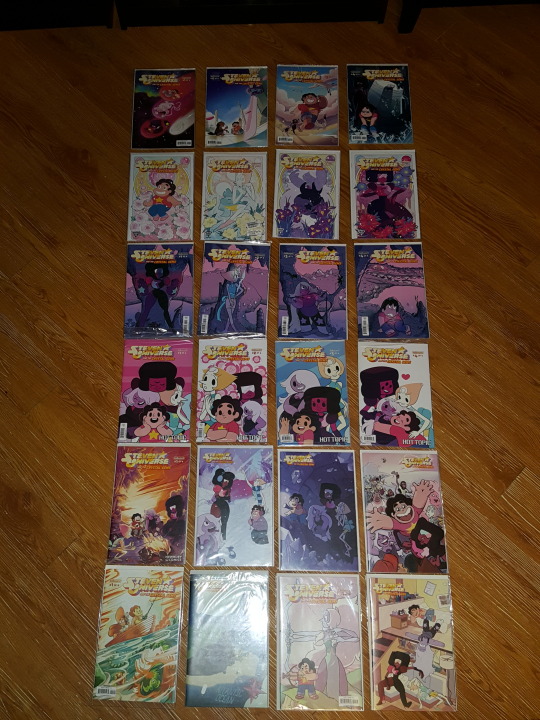
Harmony Covers
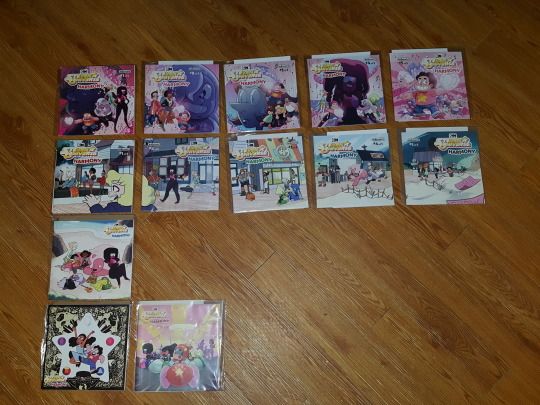
Special Issues Covers
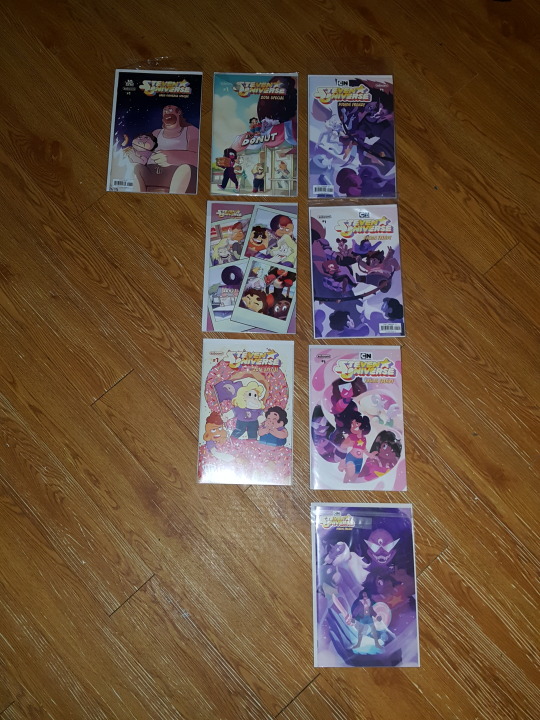
Zines, related materials, and compilations
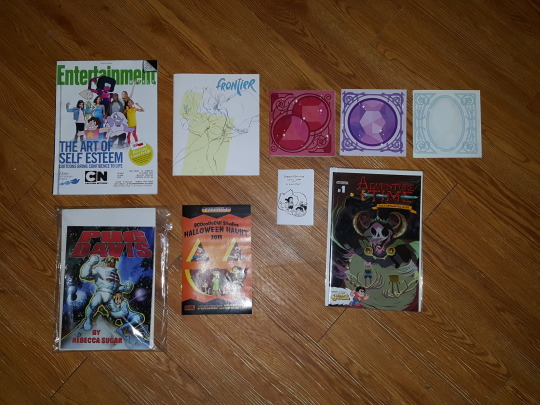
SDCC Zuke/Tang Zines with all 3 covers

(Some non-rare comics not pictured. No books included; I believe none of the books that have been released are rare.)
Trading Cards
I’ve got the trading card binder and complete base sets and a lot of pink foils and some sketch cards but what people will be interested in is these:
All the Totally Fabricated Bubbled Gems Cards
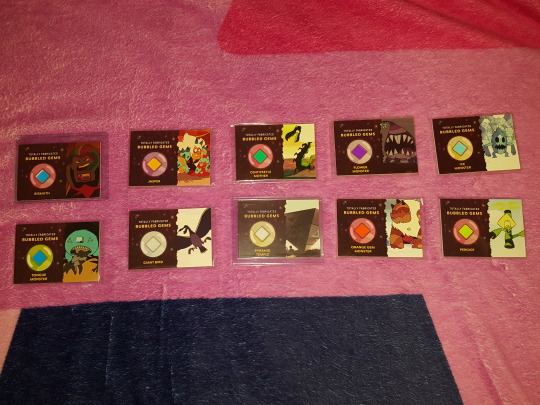
A bunch of autographed cards
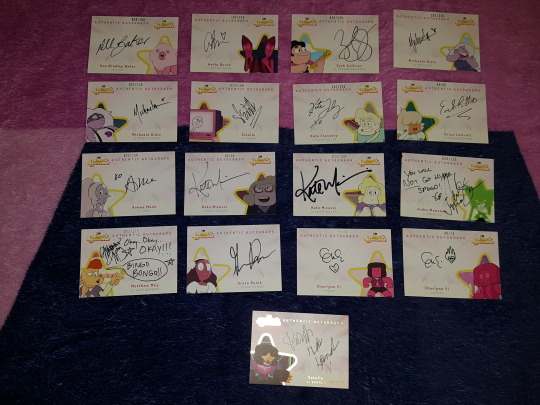
This is Dee Bradley Baker as Lion, Ashly Burch as the Rutile Twins, Zach Callison as Steven Universe, Michaela Dietz as Amethyst and as Purple Puma, Estelle as Spoon, Kate Flannery as Barb, Erica Luttrell as Padparadscha, Aimee Mann as opal, Kate Micucci as Sadie Killer and as Sadie Miller, Jinkx Monsoon as Emerald, Matthew Moy as Lars Barriga, Grace Rolek as Cloud Connie, Charlyne Yi as Navy and as Ruby, and the promo card of Estelle as Garnet from SDCC.
Accessories
Spinel Heart Enamel Pin

Crystal Gem Quartet large buttons, con exclusive
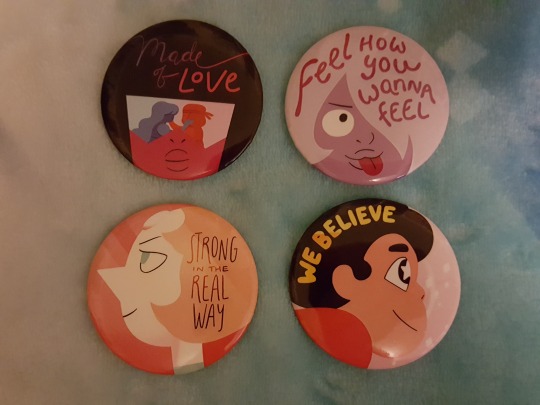
Rose Quartz Flag patch

Gem Scarf and Rose Quartz Pin from LootForHer:

Complete set of dog tags, including two rare ones
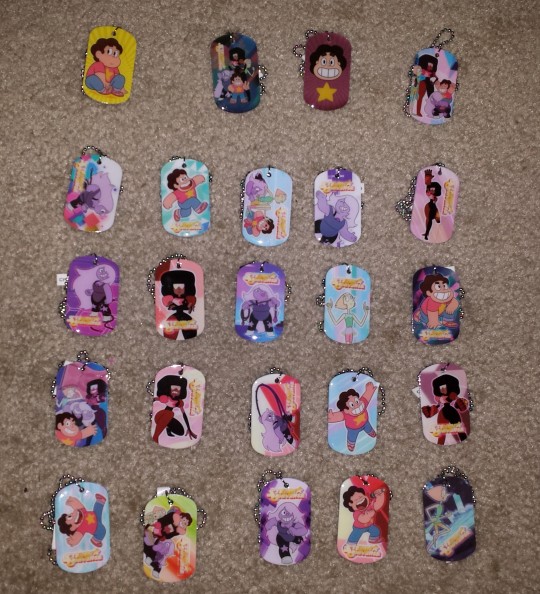
The Answer temp tattoo from book event
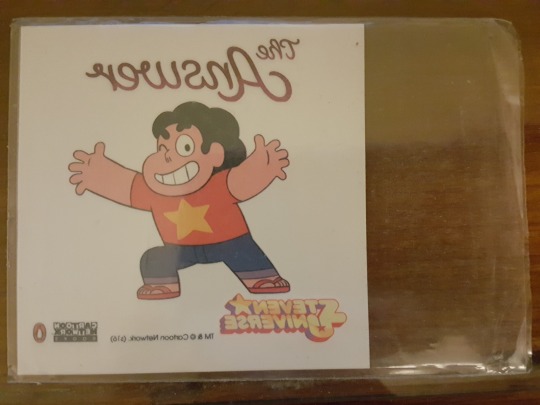
I also have a ton of stuff like earrings, necklaces, rubber bracelets, hair bows, gloves, socks, caps, lanyards, patches, and keychains, but I think they’re all easy to find.
I have a crapton of shirts, six dresses, some underclothes, shoes, costumes, and some sweaters and hoodies, but I don’t think any of them are rare enough to make this list either.
And I have board games, cards, puzzles, and video games; none are rare as far as I know. Up in my house there are some things like magnets, air fresheners, the Rose Quartz flag, the Lion coin bank, stickers, and various bags like the Cheeseburger and Hot Dog, towels, pillowcases, wallets, calendars, and journals . . . but again, far as I know they are not rare.
And I don’t know what category I’d put these in but
CN Steven Penny???
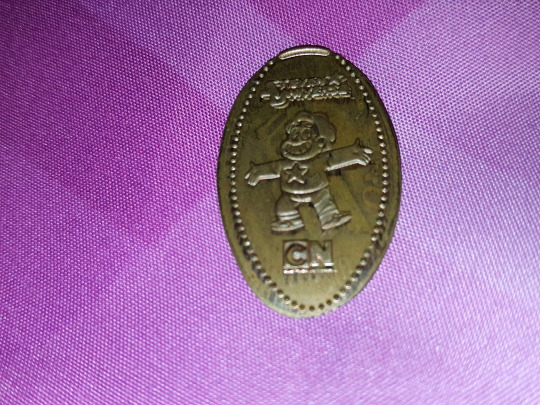
Official Karaoke Microphone???
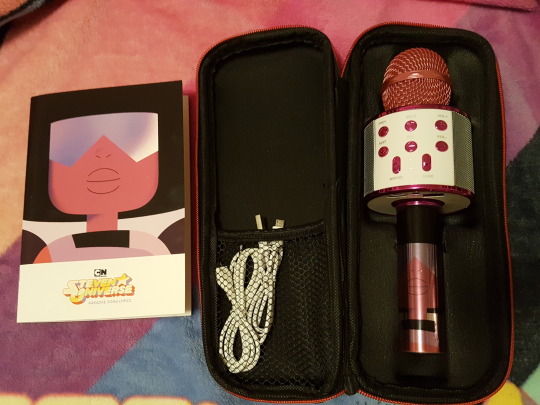
Let me know if you’re wondering about whether an item is in my collection that I just may not have or may not have known was rare? (Yikes this post got long.)
332 notes
·
View notes
Text
A New Adventure - Pt. 5
Okay, y’all, I know I have been extremely absent on this fic and it’s because I’m taking inspiration for this from my real life, but Covid literally destroyed all my plans and therefore put a halt on my inspiration for this. Also, feedback and people asking about if this would be continued literally saved this fic’s life! Don’t ever think that I don’t read your comments or put any weight to your feedback, because that is literally what got things rolling again for this one. Anyways, rant done! Happy reading!
Masterlist
Read on AO3
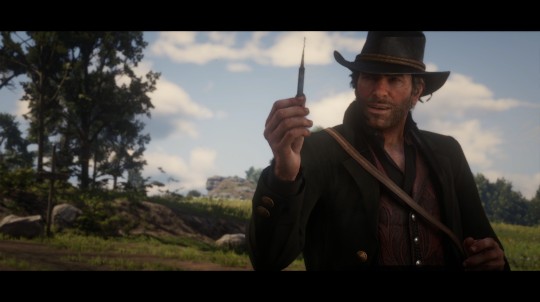
Quarantini, anyone?
(Authors note: A lot of things, especially towards the end, are extremely fictional and have very little fact and I gloss over the aspect of time. Please don't hate me for that. I'm writing this purely for fun!)
Weeks before you'd met Arthur, you'd heard of the Corona virus. But it was in China then, certainly not a problem in your state.
After meeting Arthur though, the first case in Utah was reported. Still, it wasn't a bother. You thought nothing of it.
That was until, a few weeks later, news reports were that reported cases were skyrocketing. You looked up the symptoms and who was most at risk. Your heart dropped. Arthur was the perfect target as his immune system was highly affected by the TB.
By this point, everyone in your office knew you had a roommate, but not much more than that.
When you discovered Arthur was highly at risk, you decided not to take chances with him and asked to work remotely, to self quarantine.
A week later has gone by and the entire state is in quarantine anyway.
Arthur's confused. He's never heard of Covid, obviously. Why would he have? He finds it incredibly strange that a disease that was first reported in Asia has so quickly become a problem in the states. You have to explain internationality to him and how the entire world is basically connected.
Unlike the rest of the state, you decide not to go crazy and wipe out the shelves of toilet paper and other items. You're lucky in that you bought a large packet not long before this started.
Still, the demand for certain items surprises you and Arthur.
"What you supposed to do during a… quarantine like this?" he asks.
"I don't know, Arthur. The last big pandemic was during 1920 I think. Obviously long before my time."
This is a whole new experience for both of you.
Luckily you're easily able to set up an office at home so you can still work and not have to worry too much about money. However, your amount of work is affected.
You get worried rather quickly about how much work you're going to get. If you don't get work, you don't get paid.
Arthur sees you worrying, even though you don't say anything. He tries to help lighten the load, but there's not much he can.
Money is getting tight. You're starting to have to withdraw from savings. It doesn't help that Arthur will need a refill on his meds and they weren't cheap the first time. How the hell are you going to afford to take care of him and your dog?
Arthur is starting to worry about you. He knows how little sleep you've been getting, despite barely leaving the house.
One night, Arthur sits you down on the couch before dinner and asks you to share your worries with him.
You've been so strong in front of him up to this point, not wanting him to see you as weak or pathetic. But that night, you break down. It helps to voice your worries, even though you know there's nothing he can do.
At least that's what you think.
The weekends are when you go to the store. Arthur's been coming with you more and more to the store. He likes to see what the world is like now.
When you tell him to get ready to go to the store, he says he's not feeling very well. He has days where his TB is just worse than others. Although he's responding wonderfully to the medicine, it still seems to kick his ass. So he says he's going to stay home, get some rest.
You bid him goodbye, saying you'll be longer than usual as you need to go to the pharmacy and get him more medicine.
Your stomach drops when the pharmacist tells you the price. Thank God for your flex spending account, but it doesn't pay for the inhaler refills. Those you have to buy yourself, and it's nearly $100. You sigh. As much as you love having the Arthur Morgan as your roommate, right now is the worst time with this pandemic.
When you get home and get the groceries carried in, Arthur puts a hand on your shoulder.
"Y/N, before we put things away, I need to show you something."
"Arthur, I got cold stuff. Will you help me? It'll be twice as quick."
He gives you a sweet grin that makes you blush and agrees. Funny. You know what he's like on the days when he really doesn't feel good. He's usually lethargic and coughs a lot. Sometimes he even vomits. Once he fell unconscious and you had to drag him to bed (which was nearly impossible. He's a big, broad guy).
Today though he's acting relatively normal. As you look a little harder at him as you move around the kitchen, putting things away, you notice he's got dirt on his skin, under his nails. His right elbow has a large scrape on it.
As soon as everything's been put away, Arthur offers you his hand. This makes your stomach flip. He's never tried to hold your hand before this.
He leads you into his bedroom and flips on the light. On his bed lies a large pile of money. Stacks and stacks of bills, piles of coins. What the hell?
After inspecting them, you notice the bills are not common day dollars. They're much bigger, the designs different. They're bills from the 1890's. The coins are exactly the same.
"I knew you was worried about money and I know I been a burden." You try to argue but he stops you. "So, when you was at the store, I snuck back to my world."
He coughs as he says this. He's visited there a couple of times and every time he does, his TB comes back in full swing, making him relapse until he returns.
"I found a few treasure maps long before I got here," he continues. "So I managed to track 'em down. Also pulled a quick robbery on a bank stage. Anyways, thought this could be my way of contributing."
You can't believe he's done this for you. You know Arthur has a soft, gentle side, but even you didn't expect this.
After counting the money, it all comes to over $1500. That will cover your expenses for over a month and adding what money you are making, you'll be fine. For a few months anyways and hopefully by that point, quarantine will be lifted.
This all adds up and you realize you don't have to worry about money anymore. Arthur has done more for you than you could imagine and it brings tears to your eyes.
He's worried when he sees you beginning to cry, thinking he did something wrong. When you tell him it's because you're so grateful, he gives you another dazzling smile.
"I just couldn't stand letting you do all the work and me just taking advantage. Maybe I'm just so used to helping folk I care about…"
He's cut off by you hugging him. You're not a hugger, typically, but this has definitely earned him one. You hear him huff a little and he pats your back.
"Thank you so much, Arthur."
After doing some research on how to trade old bills for current ones, you end up with even more money because the money Arthur provided ends up being considered antique and "museum quality" (according to the appraiser). This means you leave with well over $50,000.
"Well well, Arthur," you say with a sly smile. "Turns out your robbing ways are still highly useful, even in my day."
33 notes
·
View notes
Text
10 Reasons Why Carrie Bradshaw Wasn’t THAT Bad...
Sex and the City is the most elite series I’ve ever watched - and I was so excited to purchase the first season when I turned 18.
I would listen to my mom and my sister gossip about the show when I was younger and feel so left out. But, my mom would refuse to let me watch it until I became an adult. Thank god.
Being an avid fan now, I sometimes scan through Sex and the City articles on the net, and can’t help but notice dozens of articles filled with ‘Carrie’ slander - which kind of makes me nervous.

Although it was true that years ago girls were labeling themselves as the ‘Carrie’, ‘Samantha’ and ‘Charlotte’ of the group - the serious and less glamorous friend got stuck with being a ‘Miranda’; it is kind of an insult now to be deemed as a Carrie.
As we all matured, we realized that being a Miranda is amazing and we should all strive to be just as successful - but Carrie Bradshaw is still a valid character and I’m here to prove why the “sexual anthropologist” is not all that bad.
Now before I dive into why I totally get Carrie Bradshaw, I would just like to point out before hand that I am aware that she is just a fictional character and hopefully you are too. If you are not informed, then I apologize for this harsh revelation. However, let’s continue.
1. She was average looking
While we can all agree that her physique only gets stronger and leaner throughout the series, she was still not exactly perfect looking. Despite her fit body, she was not model like or necessarily tall. She did not have a perfect nose. She did not have the biggest ‘lady parts’. She did not have the plumiest lips. She did not have perfect facial symmetry.
But, she was okay with it. And has mentioned that by the age of 30, she was over being uncomfortable with her looks and decided to move on.

Despite constantly bumping into models and having to accept that men can be total “modelizers” - especially in the capital of the world aka manhattan, she chose to embrace her natural beauty, which in turn has allowed her to walk the runway in her underwear.

2. She was selfish
Yes, the new trend is to be selfish and say no - because that is ‘self love’.
If that truly is the case, then there was no denying then that Carrie was selfish throughout the series.

As human beings, we are selfish by nature. But since we now identify ourselves in societies with expected norms and values, being selfish disqualifies you sometimes from your environment. To avoid being lonely, we try to let go of being selfish or at least hide our selfish traits.
Unfruitfully so, our selfish instincts at times fail us - exposing our true colors. And whenever that happens, people aren’t too afraid of pointing out what you did wrong. It doesn’t make us necessarily evil, just makes us human.
To avoid being Freudian in this post, let’s just sum up that Carrie is harmlessly selfish at times - that includes being late to every event, asking her friend Susan Sharon if she could trade in her cashmere sweater birthday gift for cash, accepting a pair of 600$ shoes from her other super rich friend, and cutting off Charlotte’s possible infertility problem discussion to talk about her Manolos.

The list goes on, I mean - this is just classic Bradshaw behavior. However, this character cannot be deemed as bad. She was just under the spotlight, and if we were under it too, we would find out that we do have these moments as well without realizing it. We are not perfect. However, Carrie does reflect on her mistakes often, which is something we should be doing more.
Sometimes, her selfish tendencies can really get out of hand.
It was not okay when she got angry at Charlotte who did not offer to lend her money after she blew it all off on Manolo Blahnik shoes instead of rent. It was not okay when she threw away Aiden down the drain. It was not okay when she slept with a married man, even if it was ‘Mr. Big’.
We cannot shame her though because we all have hidden skeletons in our closets...it’s up to you however to peak in and see which faults make it or break it for you.
3. She was a working woman
No offense to chastity ball princess Charlotte, who wanted to be a housewife to any rich man who crossed path with her, Carrie Bradshaw was by all means an ‘all star’ business woman. Despite being unconventional unlike Samantha Jones (PR executive) and Miranda Hobbes (Harvard-graduate Lawyer), Carrie Bradshaw was a restless woman that worked in multiple fields all at once despite being so undermined.

She had so many tasks to tackle all at once while juggling multiple projects. She ran around between the fields of Journalism, Content Marketing and Public Relations. She was able to get invited into all the ‘fabulous’ events and meetings because of the hard work she invested in all by herself as a freelancer who lived in a huge place like New York. Carrie finally reached her goal at the age of 40, which was working at Vogue. She even wrote multiple books as well.

4. She was unconventional
Despite the show running in the early 90s, Carrie Bradshaw decided to be a sex columnist. She never gave up on her weird unconventional job and was proud of her career despite the looks or comments people would make. She had a weird exterior in addition to how upfront she was about the physical makings of life.

In addition, Carrie did not believe in marriage until she became a fiancée at the age of 40. She traded in a ring for a pair of shoes and a walk-in closet, unlike most women, who would rather get married in their mid 20 to early 30s with a huge rock on their finger.
5. She was struggling at adulting
Carrie Bradshaw had a deluded concept of adulting that at least most of us had or still struggle with. She was not a healthy adult with financial stability and a well thought out regime. However, she still managed to be fabulous.

She had poor dieting habits, which made her sometimes skip dinner to buy Vogue instead. She believed that shopping and gossiping were the best types of cardio. She was not the cleanest and had a messy apartment at most times. She did not care about the way her living space looked like, which she later on freaked out about in fear of being judged as an imperfect adult according to Mr Big. She paid so much on shoes that she could no longer afford her rent. She believed that investments must be seen in her closet. She drank at least six dollars worth of coffee per day. She would smoke and drink way too much for a thirty year old woman.

6. She was a good friend
Carrie Bradshaw had so many friends that it almost put her PR bestie Samantha to shame. To be honest, Carrie may have not been a perfect friend, but she was as good as it gets realistically.
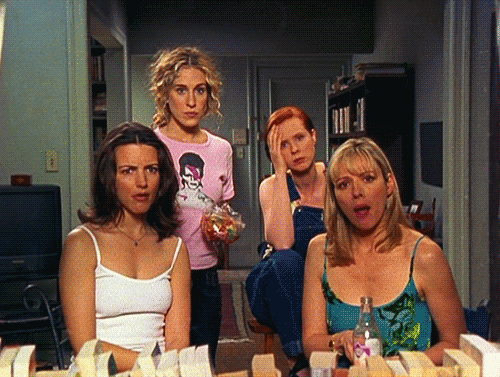
What made her so realistic in her friendships was her ability to be there for most of her friends’ hardships. She had her ups and downs with her empowered female group because sometimes they would feel like she was too problematic and vice versa. For the most part, it is impossible to be as passionate to your friends as you once were the first time you guys met. But what makes a friend a good one is that they never voluntarily try to find excuses to leave you behind.
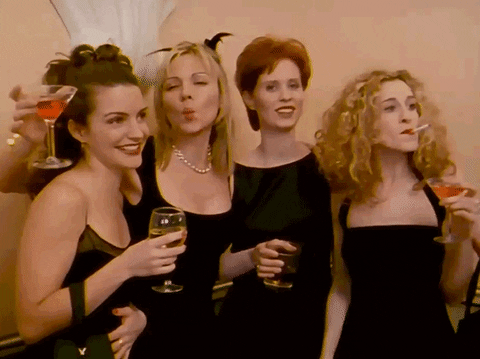
Carrie’s love towards her friends in her good and bad times showed that she valued them like family.
7. She was lost
Carrie was probably more lost than she would have liked to be. She had a tendency to dwell on what should have been and could have been. We all have regrets and sometimes she voiced hers out more than other characters within the show. She would sometimes yearn over the years that passed by her. She even went to extremes such as dating a college boy just to remember what it was like to ‘just kiss’. Rookie Mistake, Carrie.

Just like Carrie, as time goes by at any age, we look back at the spur of events that created our timeline and take note sometimes of which events we deem as either life-changing, traumatizing or both.

8. She was experimental
She may not have been as promiscuous as her friend Samantha, but she was unarguably adventurous in all aspects of her life. Although the most obvious aspect may have been her outfits, her wild colors and funny textural accessories were just a preview on how eccentric Carrie Bradshaw truly was. She mentioned that her younger years were a genuine pursuit of fun in every shape or form, which most twenty-something-year-olds cannot deny.

She emphasized that she fears living life as a cautious person because of the hurt she has endured. However, she truly defined throughout the show what it means to be eccentric, empowering the ones who fail the experiments of life to get back on their feet.
9. She was flawed
Carrie Bradshaw believed in the glass half full rather than half empty throughout the series. Despite being unbearably flawed to the point where her friends no longer wanted to listen to her problems, she decided to see a shrink which is something that would have been especially socially-unacceptable in the 90s. Carrie still overcame her mental issues and found other remedies which in turn has led her into accepting the way things played out.

As we grow up, we, like Carrie, need a little bit of help in order to realize that temporary issues will fade away into lessons and the permanent ones that are out of our control can be accessorized into our lives accordingly to the way that we want it to look like.
10. She was in love
Her love towards Mr Big was illogical - almost completely insane. But what made her character so special was the fact that she never continued her relationship with Aiden because she knew deep down that it was Mr Big all along and never gave up on it; despite all the signs that kept telling her that he was bad for her. He was at the time indeed bad news, which made her feelings towards him fluctuate between love and hate.
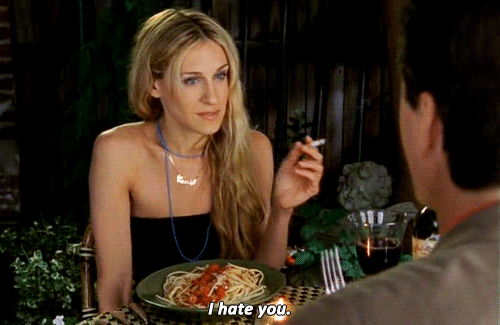
Now, the psychology behind her and Mr Big does not justify why you should call your ex right now so put your phone down, but it is something to think about.

Carrie took the road not taken for most women, especially during the 90s where gender roles in love where still a bit rigid. While it is true that it is always easier to date lovers who make the effort to chase you rather than pursuing it yourself, the easiness does not create the ‘fairytale love’ that most of us strive for.
Carrie once described her love towards him as a crash rather than a crush. But if something deep down is telling you that someone is your person, shouldn’t that account for something? Shouldn’t we all just go for ‘ ridiculous, inconvenient, time-consuming can’t-live-without-each-other love’, and get it right just like she did?

- Nina xx (yasminasayyid)
#carrie bradshaw#Sarah jessica Parker#satc#sex and the city#sex and the city 2#Samantha jones#Miranda hobbes#quotes#mr big#Charlotte york#chris north#Cynthia Nixon#kim cattrall#kristin davis#new york#Manhattan#new york city#vogue#cosmopolitan#beauty#buzzfeed#betches#media#psychology#content marketing
59 notes
·
View notes
Note
Author, Manuscript and Epeolatry for the Book Ask please :3
coming to this very late but the activity page on tumblr buried this ask!! this is censorship
author. what is a book you really regret buying? 👀 going straight for the shade, are we? this is actually pretty difficult, because i don’t buy physical books unless i’ve already read and loved them, and in general i don’t spend more than $4.99 on an ebook anyway because i buy them when they go on sale. unless it’s really racist or homophobic or something it’s difficult to regret spending $5 on a book.
if i were to be honest, the last book i bought that i really regret is my spanish 201 textbook, given that i dropped the class about eight hours after i paid $120 for it. in general, i resent buying textbooks because i can’t wait until they’re on sale to buy them. but if you’re looking for more of a classical “i thought i would like it and i didn’t” answer, that’s probably andrew blum’s tubes: a journey to the center of the internet. i only spent about a dollar on it, but i bought it in the full expectation that i would love it and i... did not. it takes a really particular talent to make technical issues vivid and comprehensible to the layman, and instead this is just 300 pages’ worth of metaphors that don’t actually bring me any closer to understanding the physicality of the internet and dry technical history that i don’t care about.
on a lighter note, you’ve seen the photo of all my shakespeare folger editions side-by-side, and i have regrets about the fact that i own like ten (10) mass market paperbacks and one (1) trade paperback of twelfth night. but the mass market paperback would’ve taken longer to ship. again, the requirements of school destroy my aesthetic.
manuscript. what is a book you want to read but are intimidated by? haha, i’m intimidated by all my books. everything on the top tier of my to-read list looks so good that i almost want to wait until i’m in the perfect mood to crack one open. of course, i did that, i’d never read anything, so i usually ignore this feeling. just a sampling of books i currently feel this way about:
erin claiborne's a hero at the end of the world, which i've had on my shelf since literally it came out
naomi novik's entire ouevre, which i've had on my list ever since i found out she was astolat, but her a deadly education has recently gotten a boost since it's become my best friend's most recent favorite
lisa ko's the leavers, about a boy who is abandoned by his undocumented mother and adopted by a white couple
casey mcquiston's red, white & royal blue, which i've been putting off because i don't really like romance
michael chabon's the yiddish policeman's union, about a murder mystery in an alternate universe where alaska was established as a jewish homeland in the wake of wwii
n. k. jemisin's the fifth season & the hundred thousand kingdoms, which i sincerely hope will live up to their hype
and much, much more
if i had to say what on the top tier of my list i’m most intimidated by at the moment, it would be diving into fan studies. i've got a huge list of academic texts to read, from hellekson & busse to jenkins, but the idea of just diving into a whole field of study is daunting. for class, i’m reading moby-dick now, which is the definition of “too intimidating to actually open,” so we’re in a “dive right in!!” kind of mood.
epeolatry. what is your favorite book quote? this is also hard because i don’t remember specific quotes!! every now and then something will hit me hard, but plenty of literary moments can accomplish that. theoretically, it would be something from my favorite book, right? ...if roughly half my book collection weren’t currently in a storage lock-up 1,700 miles away this would be easier.
but beautiful prose is easy to come by. what makes a book for me is a genuinely emotional moment, one that ties the themes & motifs of a book together. hmmm. in that case, possibly “pack my box with five dozen liquor jugs” from mark dunn’s ella minnow pea. if you want to find out how that manages to be a beautifully triumphant and stunning moment... you’ll have to read it. 😉
4 notes
·
View notes
Text
For everyone bitching about Sword/Shield’s expansion, the cost, and Pokemon HOME...
You were never able to catch all the Pokemon in one game in the entire history of the series. Trading with other people has always been a thing, and the FREE UPDATE to go with the expansions (free, as in everyone gets it) gives you the ability to get all 200 new Pokemon in your game without paying a cent, you just have to trade with other people for it. Like you always have had to do. In every single generation. Ever. Why is this suddenly such an offensive concept? Game Freak has intended, since Red and Blue, for you to go ask people to trade with to finish your dex. If you bought both versions and two consoles to get everything that is 100% on you -- you were the one inflating the cost yourself, not Game Freak. That was not by design. And with the introduction of the internet, even without the GTS, you can trade for whatever you need massively easy. Just google “Pokemon Trades Forum” or go onto r/PokemonTrades in reddit. If you feel the need to catch everything yourself, that’s perfectly fine and dandy! You do you. But that is on your shoulders and yours alone. It has nothing to do with Game Freak or Nintendo. Stop blaming them for your decision.
The expansions are 30 dollars for 200 new Pokemon, 2 new huge areas, and more story. You seriously pay 30$ to get well over half the game again, all of it new, rather than paying 60$ for a third expansion that is mostly the same (which I always disagreed with, just so you know). Why are you flipping your shit over this? This is good! We get way more value for our money!
Y’all cry and cry about the expansion’s price and how HOME has a cost and the Nintendo sub has a cost, but why do you never bring up the costs? The Nintendo Online subscription costs 20$ a year to be able to play every single thing on the Switch online (or 35$ a year for eight people, meaning you could split it up so every person paid about 4-5$ a year). Y’all, the Playstation and Xbox subscriptions are $60 a year at minimum, for one person. That is literally over double the price that Nintendo is asking. Why the fuck are you up in arms about Nintendo giving the same main access (online play) for a much, much more reasonable price? You guys better be railing against Playstation and Xbox too if you’re gonna be shitting on Nintendo.
Oh, and Pokemon Bank costs 5$ a year to store and transfer every single one of your Pokemon and even keep up its own Pokedex for you. A real bank breaker, right? What makes you think Pokemon HOME is going to cost much more than that? EDIT: LMAAAAAAO NINTENDO, NO. Rest of this stuff still mostly holds but the Pokemon HOME thing is... nah.
I just don’t understand why Sword and Shield were heralded with the massive amount of hate they got. Why is the Pokemon community so toxic now? It’s basically as bad as the Sonic community. Are you guys trying to match Call of Duty for being a shitty, hateful, toxic fanbase?
If you don’t like it, there’s nothing wrong with that. But stop lying about shit. Stop comparing Nintendo to EA (what the fuck?), stop comparing Sword/Shield to Fallout 76 (what the fuck?), stop outright blowing up falsehoods about the game, Game Freak, and what Nintendo is doing like they’re somehow as scummy as companies that have literally exploited gambling mechanics or lied to players’ faces about everything. You just make yourself sound fucking stupid when you do that because it’s blatantly untrue. If you want to rail against something, use facts, not this shit you’re throwing around because so many of you got upset that the trees were stylized and not super-realistic in a Pokemon game or because Game Freak outright told you they wanted to make a better game than include all of the pieces of digital blocks and were going to rotate them per-game now.
Any of y’all that have facts, like “I didn’t like that Nintendo seemed to lie about making the models from scratch” or “I just personally don’t like the games for [real reasons that actually exist, like not liking the roster]”, I have no beef with you. You guys are fine and I would defend you to the death. I just can’t stand people who piss all over a game for things that aren’t actually problems, either because they’re judging it unfairly compared to everyone else or because the shit they’re spewing isn’t actually real and doesn’t exist.
But, more than anything else. The most important of all?
Stop shitting on people and trying to ruin their enjoyment of something just because you don’t like it.
70 notes
·
View notes
Link
Yesterday CNBC reported that Citigroup is one of the banks selected by the Small Business Administration to handle billions of dollars earmarked in last week’s stimulus bill to help small businesses get back on their feet and keep their employees paid during the coronavirus crisis. Citigroup’s Citicorp subsidiary was charged with, and pleaded guilty to, a criminal felony count brought by the U.S. Department of Justice on May 20, 2015 for its role in rigging foreign currency trading. Its rap sheet for a long series of abuses to its customers and investors since 2008 is nothing short of breathtaking. (See its rap sheet at the end of this article.)
During the financial crash of 2007 to 2010, Citigroup received the largest bailout in global banking history after its former top executives had walked away with hundreds of millions of dollars that they cashed out of stock options. Citigroup received over $2.5 trillion in secret Federal Reserve loans; $45 billion in capital infusions from the U.S. Treasury; a government guarantee of over $300 billion on its dubious “assets”; a government guarantee of $5.75 billion on its senior unsecured debt and $26 billion on its commercial paper and interbank deposits by the Federal Deposit Insurance Corporation.
Sandy Weill was the Chairman and CEO of Citigroup as it built up its toxic footprint and off-balance-sheet vehicles that blew up the bank. Weill was also the man who engineered the repeal of the Glass-Steagall Act, the depression-era legislation that had safeguarded the U.S. banking system for 66 years before its repeal in 1999. Weill needed the Glass-Steagall legislation to vanish so that he could merge his hodgepodge of Wall Street trading firms (Salomon Brothers and Smith Barney, et al) with a federally-insured bank full of deposits. Weill told his merger partner, John Reed of Citibank, that his motivation for the deal was: “We could be so rich,” according to Reed in an interview with Bill Moyers.
The repeal of Glass-Steagall meant that the casino-style investment banks and trading houses across Wall Street could now own federally-insured commercial banks and use those mom and pop deposits in a heads we win, tails you lose strategy. Every major Wall Street trading house either bought a federally-insured bank or created one. (See the co-author of this article testifying before the Federal Reserve on June 26, 1998 against the Citigroup merger and the repeal of the Glass-Steagall Act in this video.)
What Weill meant by “We could be so rich” was this: If the trading bets won big, the CEOs became obscenely rich on stock-option-based performance pay. When the bets lost big, the government would be forced to do a bailout rather than allow a giant federally-insured bank to fail. This is why the Federal Reserve had to secretly plow $29 trillion into Wall Street banks and their foreign derivatives counterparties between 2007 and 2011 and why the Fed had to open its money spigot again on September 17 of last year – months before there were any reports of coronavirus COVID-19 cases anywhere in the world.
Sandy Weill became a billionaire at the merged Wall Street bank, known as Citigroup, through a technique that compensation expert Graef “Bud” Crystal called the Count Dracula stock option plan – you simply could not kill it; not even with a silver bullet. Nor could you prosecute it, because Citigroup’s crony Board of Directors rubber-stamped it. The plan worked like this: every time Weill exercised one set of stock options, he got a reload of approximately the same amount of options, regardless of how many frauds the bank had been charged with during the year. (And there were plenty. See rap sheet below.)
Writing at Bloomberg News, Crystal explained that between 1988 and 2002, Weill “received 96 different option grants” on an aggregate of $3 billion of stock. Crystal says “It’s a wonder that Weill had time to run the business, what with all his option grants and exercises. In the years 1996, 1997, 1998 and 2000, Weill exercised, and then received new option grants, a total of, respectively, 14, 20, 13 and 19 times.”
When Weill stepped down as CEO in 2003, he had amassed over $1 billion in compensation, the bulk of it coming from his reloading stock options. (He remained as Chairman of Citigroup until 2006.) Just one day after stepping down as CEO, Citigroup’s Board of Directors allowed Weill to sell back to the corporation 5.6 million shares of his stock for $264 million. This eliminated Weill’s risk that his big share sale would drive down his own share prices as he was selling. The Board negotiated the price at $47.14 for all of Weill’s shares.
On May 9, 2011 Citigroup did a 1 for 10 reverse stock split, meaning if you previously owned 100 shares of Citigroup, you now owned just 10 and the price was adjusted upward accordingly. At yesterday’s closing price of $38.51 (actually $3.85 if adjusted for the reverse stock split), Citigroup’s long-term shareholders are still down 92 percent from where Weill bailed out of the stock in 2003.
Another man that became obscenely rich from Citigroup was Robert Rubin, the Treasury Secretary under the Bill Clinton administration who helped Citigroup advocate for the repeal of the Glass-Steagall Act. Without any meaningful cooling-off period, Rubin went straight from his government post to serve on the Board of Citigroup. Rubin received more than $120 million in compensation over the next eight years for his non-management job.
John Reed had a falling out with Weill and retired from Citigroup in April 2000. In Monica Langley’s book, Tearing Down the Walls: How Sandy Weill Fought His Way to the Top of the Financial World. . .and Then Nearly Lost It All, the author reports that Reed owned 4.7 million shares of Citigroup on the date of his retirement. Langley also writes that “Reed immediately began selling his Citigroup shares and laid plans with his second wife to buy a house on an island off the coast of France.”
If Reed sold all of his Citigroup shares over the next three months after his retirement at an average price at the time of $62, he would have realized $291 million in proceeds. According to SEC filings (see here and here) Reed also received a $5 million retirement bonus and a retirement pension of at least $2,019,528 annually.
According to the SEC filings, Reed was also to receive the following: lawsuit indemnifications arising from company employment; an office at Citigroup, secretarial support and access to a car and driver for as long as Reed deemed it “useful.” If Reed decided he needed an office outside of New York City, that would be provided with secretarial support until age 75.
When Weill stepped down as CEO in 2003, he put his General Counsel and personal friend, Chuck Prince, in charge as CEO. Prince took the fall when the company imploded in 2008. For being a good foot soldier to Weill, Prince got an exit package of $68 million.
And then there was Vikram Pandit, a hedge fund manager whom Robert Rubin selected to run the sprawling Citigroup. The Wall Street Journal reported that Pandit took home $221.5 million during his five years at Citigroup.
Sheila Bair, the head of the Federal Deposit Insurance Corporation that guaranteed Citigroup’s debt during the financial crisis, wrote this about Pandit’s persona at a meeting with other bankers in her book “Bull by the Horns”:
“Pandit looked nervous, and no wonder. More than any other institution represented in that room, his bank was in trouble. Frankly, I doubted that he was up to the job. He had been brought in to clean up the mess at Citi. He had gotten the job with the support of Robert Rubin, the former secretary of the Treasury who now served as Citi’s titular head. I thought Pandit had been a poor choice. He was a hedge fund manager by occupation and one with a mixed record at that. He had no experience as a commercial banker; yet now he was heading one of the biggest commercial banks in the country.”
When the Financial Crisis Inquiry Commission concluded its findings into what led to the financial crash of Wall Street in 2008, resulting in millions of job losses and foreclosures across America, it made numerous referrals for potential criminal prosecutions to the Justice Department. Three of Citigroup’s executives were among those referrals: Robert Rubin, Chuck Prince and former CFO Gary Crittenden. Nothing ever became of those referrals.
In 2012 the law firm Kirby McInerney agreed to settle a lawsuit against Citigroup on behalf of shareholders for $590 million. The lawsuit charged that Citigroup had lied to shareholders about its financial condition, including its losses from off-balance-sheet accounting tricks. The plaintiffs wrote this about Citigroup’s Collateralized Loan Obligations (CLOs), which were loans to lower credit-rated companies that were then pooled together:
“After purchasing insurance on a CLO tranche, Citigroup would book the difference in the cost of the insurance and the payments of the loan for the entire life of the loan immediately as if the loan had been sold…Additionally, Citigroup engaged in negative basis trades with the billions of dollars of CLO exposure remaining on the Company’s balance sheet. These trades allowed Citigroup to book immediate gain for the entire term of loans by purchasing insurance on their default and, thereby, treat the purchase of insurance as a sale of the loans when, in fact, those loans (or rather, those CLO tranches) never left Citigroup’s books…In addition to the high fees for CLO creation, the ability to create instant gain through these trades was a powerful incentive for Citigroup to issue ever riskier leveraged loans. While revenue from fees and negative-basis trades inflated Citigroup’s earnings on leveraged loans and CLOs, Citigroup kept its shareholders unaware of the artificial source of the gains or the inherent risks in continuing to operate its ephemeral money-making machine.”
After Citigroup’s massive bailout by taxpayers and the Federal Reserve, its crime spree continued. This is just a sampling of charges brought against Citigroup and its affiliates since December 2008:
Citigroup’s Rap Sheet:
December 11, 2008: SEC forces Citigroup and UBS to buy back $30 billion in auction rate securities that were improperly sold to investors through misleading information.
July 29, 2010: SEC settles with Citigroup for $75 million over its misleading statements to investors that it had reduced its exposure to subprime mortgages to $13 billion when in fact the exposure was over $50 billion.
October 19, 2011: SEC agrees to settle with Citigroup for $285 million over claims it misled investors in a $1 billion financial product. Citigroup had selected approximately half the assets and was betting they would decline in value.
February 9, 2012: Citigroup agrees to pay $2.2 billion as its portion of the nationwide settlement of bank foreclosure fraud.
August 29, 2012: Citigroup agrees to settle a class action lawsuit for $590 million over claims it withheld from shareholders’ knowledge that it had far greater exposure to subprime debt than it was reporting.
July 1, 2013: Citigroup agrees to pay Fannie Mae $968 million for selling it toxic mortgage loans.
September 25, 2013: Citigroup agrees to pay Freddie Mac $395 million to settle claims it sold it toxic mortgages.
December 4, 2013: Citigroup admits to participating in the Yen Libor financial derivatives cartel to the European Commission and accepts a fine of $95 million.
July 14, 2014: The U.S. Department of Justice announces a $7 billion settlement with Citigroup for selling toxic mortgages to investors. Attorney General Eric Holder called the bank’s conduct “egregious,” adding, “As a result of their assurances that toxic financial products were sound, Citigroup was able to expand its market share and increase profits.”
November 2014: Citigroup pays more than $1 billion to settle civil allegations with regulators that it manipulated foreign currency markets. Other global banks settled at the same time.
May 20, 2015: Citicorp, a unit of Citigroup becomes an admitted felon by pleading guilty to a felony charge in the matter of rigging foreign currency trading, paying a fine of $925 million to the Justice Department and $342 million to the Federal Reserve for a total of $1.267 billion. The prior November it paid U.S. and U.K. regulators an additional $1.02 billion.
May 25, 2016: Citigroup agrees to pay $425 million to resolve claims brought by the Commodity Futures Trading Commission that it had rigged interest-rate benchmarks, including ISDAfix, from 2007 to 2012.
July 12, 2016: The Securities and Exchange Commission fined Citigroup Global Markets Inc. $7 million for failure to provide accurate trading records over a period of 15 years. According to the SEC: “CGMI failed to produce records for 26,810 securities transactions comprising over 291 million shares of stock and options in response to 2,382 EBS requests made by Commission staff, between May 1999 and April 2014, due to an error in the computer code for CGMI’s EBS response software. Despite discovering the error in late April 2014, CGMI did not report the issue to Commission staff or take steps to produce the omitted data until nine months later on January 27, 2015. CGMI’s failure to discover the coding error and to produce the missing data for many years potentially impacted numerous Commission investigations.”
June 15, 2018: Citigroup agrees to settle with states for $100 million over charges that it rigged the Libor interest rate benchmark.
June 29, 2018: Citigroup’s Citibank settles with the Consumer Financial Protection Bureau for $335 million in restitution to credit card customers over charges that it violated the Truth in Lending Act.
August 16, 2018: Citigroup settles with SEC for $10.5 million over inadequate controls, mismarking of illiquid positions and unauthorized proprietary trading.
September 14, 2018: Citigroup settles with SEC for $13 million over charges it improperly operated its Dark Pool – an internal stock exchange where it is allowed to trade its own stock.
May 22, 2019: Citigroup settles a money laundering case with the U.S. Department of Justice for $97.44 million.
November 26, 2019: Citigroup settles with the Bank of England’s Prudential Regulatory Authority for $57 million over charges that it incorrectly reported the bank’s capital and liquidity levels.

.
19 notes
·
View notes
Text
I have been here for an entire year.
Within one week straddling late March and early April 2019, I found out that I got passed over for the dream job I was certain I had in the bag, that the writing I submitted to Steam Ticket wasn't going to get published, and the job I had been doing for nearly two years and had seriously begun to loathe was firing me.
I did not recover from this smoothly.
Instead, I didn't find a new job, and months of being short on rent and bills caught up with me very quickly, and I was threatened with eviction. Luckily, a few of my friends were willing to help me with bills so that I did not get evicted, and another friend was willing to let me stay at her house once I had to leave the apartment until I had somewhere else to move to.
That move would be to my parents' new house outside of Sauk City, Wisconsin. They offered to let me stay with them on a few conditions. These conditions are here reproduced without any editing: You will daily look for a job Maintain a first shift sleep-wake schedule No video games No gaming equipment No anime or comics No occult books No hard rock music If friends come to visit, you will remain chaste in our home. We expect your help as we settle in, and that may vary as to tasks You will keep your room clean So over the course of the move, I sold my PS2 and my N64 and gave away my PS4 and my Xbox 360, though I kept the hard drive. I tried to sell my Gamecube, but it wasn't in good enough shape for anyone to buy. I kept my Nintendo Switch, my New 3DS XL, and my PS Vita, figuring I could keep those hidden enough as handhelds. My PSTV I had lent to a friend months previously. I also sold nearly all of my physical video games, my soundbar and my television set.
On June 19th, 2019, with the help of the friend who had housed me and now owned my old PS4, I moved from La Crosse, Wisconsin -- the city I had lived in on and off since 2008 and permanently since 2014 -- to my parents' house. On the way, we stopped in Madison, Wisconsin so I could rent a storage unit. In there I put a bunch of stuff I wouldn't need at my parents' house, including almost everything that they would have objected to. In went my Magic the Gathering cards. In went my anime wall scrolls. In went my comics and manga and Gamecube and remaining physical console games and books like "The Ethical Slut" and "Werewolf: The Apocalypse" and "Things Not Seen" which isn't even about magic or the paranormal but my mom still decided to steal it from my room once many years ago and hide it in the tool shed with my Harry Potter books and Bionicle trading cards. I also felt I should keep my Legos and stuffed animals in there too. But it wouldn't be long before I could find a full time job, get my own place, and get these things back where they belong. Except I have been here for an entire year. I was never supposed to be here this long! I really wasn't! I worked a hell of a lot. Daily looked for jobs. Even found a few. Overworked myself just about to the point of breaking. But just as I finally got a full time with benefits that would help me build a groundwork for the future… well, people realized that there was a global pandemic going on and shut down stores. My company laid off everyone who had been there 90 days or less. And I mean completely laid off with absolutely no promise of a return. My boss said that if they manage to get to a place where they could hire new people again, they would love to have me back. But she also said that she doubts that they will be in that position any time in the foreseeable future.
So.
I am still here. Which is not to say that it has been a complete wash. After all, as devastating as it was to lose my job, I cannot imagine how much more devastating it would have been if I had been living on my own and had to worry about rent or food. It really is too easy to dwell on the feeling of failure that comes from realizing I have been here for an entire year. I suppose I had better take stock of all the good things that have happened and that I have accomplished since I moved in. 1. I finished my writing portfolio, a project I started for a class in 2013 and had been absentmindedly poking at since then.
2. I rebuilt my entire resume from the ground up. 3. I read a total of 54 books in 2019. Not bad for only having read 2 the year before. 4. I started volunteering at the Sauk City Public Library, which has been fun and fulfilling. 5. I have been hired at Target, Madison College, PrePlayed and Half Price Books. I even managed to work several weeks between 40 hours and 65 hours, something I didn't think I was capable of. I may not have those jobs anymore, but being hired four times in a year is nothing to sneeze at. 6. Except I haven't been hired four times. I have been hired five times. The library was so impressed with my volunteering that when a position for Library Assistant opened up, they asked me specifically if I wanted it. Though I originally turned them down in order to work at Half Price Books, I was pleased to find that it was still open once I had lost my job and once libraries were re-opened for curbside checkout. So I asked and they hired me. It's only part time, but it is far better than nothing. 7. I have read a total of 66 books this year and we are not even at the halfway point. 8. I have finished writing two long-form fics: the poem fic The Revelation of Takaya According to Jin and the literal actual novel A Legitimate Businessman. In fact, at least 30,000 of the words for A Legitimate Businessman were written since I moved in here. That's some pretty hardcore proof that I can actually write an actual novel, something I assumed I just did not have in me. 9. I have paid off thousands of dollars in debt. All that remains is two friends and my student loans. I do not expect to pay off my student loans. 10. Through working at PrePlayed, I acquired for free two PS2s, an Xbox 360, one or two more Xbox 360 hard drives, and a Wii, which I gave to a friend. I have acquired at low cost two wireless guitar controllers for Rock Band, a PS3, and all the controllers and cables I needed to make these and my gamecube work again. I also got a bunch of games and a Gameboy Micro. On Black Friday, I purchased a steeply discounted new PS4 Slim. All of these now reside in my storage locker, except for the Gameboy Micro and the PS4, which are hidden in my room alongside my handheld systems. My hubris may be showing, but so far I have not been hit with a consequence. 11. I bought myself a new ukulele as an upgrade from the one I bought in 2011. It has a built in tuner, a neck strap, and a jack to plug into an amp. 12. I am now paying my own cell phone bill, which I have done reliably for an entire year alongside my storage locker bill. 13. I have gotten three works published this year so far and may still yet have a few on the way. 14. I've made more through Redbubble in the last year than I ever have before. In the process, I have learned a lot more about graphic design. 15. I may not be writing every day, but I am writing MOST days, something that was certainly unthinkable even last year, let alone two years ago. So. There still is lots of work to do. I still need a full time job. I will likely need to rebuild my entire resume from the ground up AGAIN. I still want out of this place. I still need a way to be authentically me. But my parents have been supportive and caring, even with their restrictive rules. And the environment has probably been less restrictive than I imagined it would be. But there's so much I still want to do and so many things I still want to be that I do not feel I can do or be here. In exactly three months, I will turn 30. I truly, truly, truly hope by that time I will have a concrete plan to get out of here. But I guess I have still done a lot.
8 notes
·
View notes
Text
Titaniumtv For Organisation: The Guidelines Are Made To Be Busted
iTunes Top 20 Many Downloaded Songs of All Time
However, LastPass really feels a little more secure and also pleasant (normally), particularly with its extra authenticator app. This is a top 10 listing of one of the most used smartphone apps in the UNITED STATE as of August 2017. All of these apps originate from publicly traded business based in The golden state. Like mobile phone, conference scheduler applications are moving from a nice-to-have deluxe to essential requirement in the lives of effective people.
With its wise style and also a comprehensive collection of foods, it makes swiftly logging the calories you take in as well as what you shed while exercising a breeze. A barcode scanner makes it also easier to log that post-workout treat. This physical fitness application additionally plays wonderful with various other such apps, so your information will not be tied up in just one place. MyFitnessPal won't offer you a whole workout program, however it can make you more aware of your habits.
Google Assistant/ Google Feed/ Google Browse
Those apps will likely automatically reopen anyhow if it shuts power-hungry apps. Therefore, the result is reversed and power intake could in fact boost.

What are the best free Android apps?
Subway Surfers Was the Most Downloaded Game of the Decade Success came from many different places as each of the most downloaded games came from a different company. Clash of Clans and Candy Crush Saga stand out as the only 2 apps to appear on both the top apps by downloads and consumer spend lists.
There's no totally free rate, so you'll need to pony up $10 a month. Originally, we weren't mosting likely to place any kind of launchers on this checklist. Nova Launcher seems to be prolong beyond what regular launchers are. It's been around for years, it's been consistently upgraded, and also thus it's never not been a fantastic option for a launcher replacement. If you desire to, you can also make it look like the Pixel Launcher.
What you make on your phone will certainly look specifically the same on the desktop. Dropbox originated the personal cloud solution, where all your stuff would certainly be readily available no matter what device you were using. On Android, it holds its own-- also versus the very incorporated Google Drive. Dropbox can likewise function as a smooth backup for your photos, immediately publishing every picture to the cloud.

Worldwide Top Apps by Google Play Downloads.
The Android app lets you take your jobs on the move and also offline, syncing your development when you're back on the network. It's an effective device with an outstanding user interface, and new features are added routinely. Hulu has actually long been a significant gamer in the on-demand streaming space and also its huge library of current and also formerly broadcast programs provide appealing choices for several. Hulu's live TELEVISION part is impressive too, with an excellent series of networks and also properly designed applications. Hulu's combination of on-demand and also online TELEVISION services makes it an excellent value.
There is additionally a second Google Assistant app for those that desire a quick launch symbol on the residence screen. The equipment things costs money, but Google Assistant is free. Amazon.com Alexa is an additional superb application in this space, but it doesn't support Google Android quite as long as we would such as, yet. 1Weather is probably the very best weather app around. It features a basic, paginated layout that reveals you the existing climate, projection for approximately 12 weeks, a radar, and various other fun stats.
Ideal Online Buying Apps in India, UNITED STATES 2020.
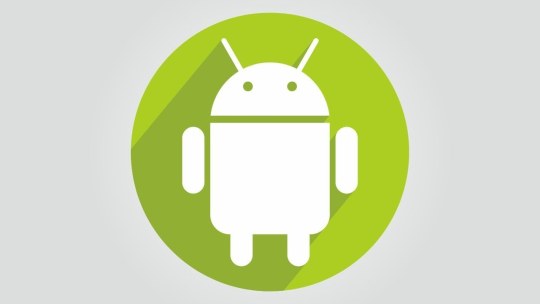
Although you need a paid Kaspersky Internet Safety subscription to use all its attributes, some standard performance is offered totally free. It seems like simply yesterday that Facebook-owned Instagram was adding video.
What apps should everyone have?
Some free apps generate revenue via in-app purchases or advertising, while others are purchased for a modest price. Even though some apps have made millionaires out of their creators, most app developers will not strike it rich, and the chances of making it big are depressingly small.
This is the checklist of the Google Play apps with over 500 million and much less than one billion downloads on distinct gadgets. Only ten applications have gone across the 5 billion downloads mark. Seven of these apps are had by Google and also come preinstalled. Facebook passed TikTok to join WhatsApp and Messenger amongst the top 3 applications. TikTok was well ahead of the No. 5 application, Instagram, with almost 65 percent a lot more sets up in the quarter.
The best dating apps for 2020.
Nonetheless, there are lots of incredible choices that do not cost you anything. These services are generally sustained by advertising and marketing, sponsorship of some find this kind, or something else. Nevertheless, there are still some genuinely excellent applications out there that you can utilize free of cost without paying a dollar. This is a finest all-time checklist, type of like hall of popularity, so the majority of these applications aren't necessarily brand-new.
What apps should I delete?
WhatsApp has 300 million daily active users worldwide. There are 300 million WhatsApp users who text using the app every day. To compare with WhatsApp's parent company, 1.5 billion people log into their Facebook accounts every day. WhatsApp's competition, on the other hand, receives fewer visits per day.
Apple Songs vs. Spotify.
You'll find it on every type of computer in every kind of setup, as well as now it's available free of charge on Android. Word plugs into Microsoft's cloud facilities to maintain your documents in order, however its major marketing factor is that this truly is Word.
1 note
·
View note
Text
Fluff Updates 4: Some Core Concepts
Well, it’s time for another one of these. We’re going to do a little housekeeping, first and foremost: we’re going to show you the currency of the world--the rainbow-colored Chromatic Dollar; the inkbloods, whose condition of is spoken of seldomly and somberly; and, rather belatedly, Toonpunks themselves! What is a ‘toonpunk’, how is it different from a ‘cyberpunk’ or a ‘steampunk’, and why would anyone want to be one? Read on and find out!
The Chromatic Dollar
If you’ve been in the open population for any length of time, you’ve probably seen or heard about the Chromatic Dollar—usually called “CDs” or “Hands”. This is the currency of the world today—not the only one, of course, but definitely the most important one. Almost everywhere you’ll ever go, hands are the preferred legal tender: you’re going to get paid in them, and odds are you are going to steal quite a few. So, for those of you who don’t already know, time to get yourselves learnt!
The CD is an asset-backed currency—which means that in theory, each bill represents a fixed quantity of ink. However, it’s not quite so simple as that (get used to that phrase, newcomers). Rather than being directly traded at a depository for ink, most CDs contains ink in themselves: each dollar is woven out of fabric, and tinted by being immersed a watered-down mixture of colored ink. When submerged in cold water, this ink can be drawn out of the bill, leaving it blank. As you may recall, inkish life needs a regular infusion of ink to survive. What this means is that chromatic dollars are, in fact, literal meal tickets: normal civilians can immerse them in cold water to bleed the ink out of them, creating a mixture that is substantial enough to maintain an inkish life form, but is not strong enough to be classified as a hazardous material.
Of course, even that is not quite so simple. Of the 7 CD denominations of CD—White, Yellow, Green, Blue, Purple, Red, and Black—only 5 actually contain ink within them. The white and black CDs do not actually contain any ink at all, due to respectively being worth very little and being worth a really great big bunch. White bills are the “single unit” denomination—they represent precisely one “CD”. They are not actually dyed, and are simply desaturated colored bills. Their value comes from the fact that they can be traded in bulk to the Morbux cartel reclamation facilities in exchange for bills of greater worth. They are often used as a baseline currency for small transactions—specifically as tips in retail or service industries.
Yellow bills are the smallest denomination which actually contain ink. They each contain approximately 1/1000 of a milliliter of ink, and are worth 500 CDs. Other denominations are Green (1000 CDs, or 1/200 of a milliliter); blue (5000 CDs, 1/100); purple (10000 CDs, or .2 milliliters); and red (50000 CDs, or .5 milliliters). Black bills, like white bills, do not contain any ink in themselves; but unlike white bills, are worth such a ridiculously high amount that it is actually impossible to store that much ink in a single bill. Specifically, a black bill is worth an entire liter of ink, or 200,000 green bills—a whopping50 million CDs. Black bills are basically never put into circulation—they were only invented so that governments and mega-corporations would have an easier time arranging bulk ink transfers between each other. Instead of physically procuring and delivering ink en masse, they could simply transfer bills (or credit for a bill, more accurately) and redeem them with their bank of choice.
History of the Chromatic Dollar
The Chromatic dollar was introduced into circulation by Black Sea Banking in 2090, 2 months after the Frontier Development Bill permitted the production and exchange of company-owned currencies. While frontier companies were the primary beneficiaries of this provision (since it allowed them to reestablish the “company store” of bygone eras) BSB was the first major company to introduce private bills for widespread circulation. A limited run of black, red, and (now-defunct) orange bills were distributed to several of BSB’s partners in lieu of liquid ink; and then, after this initial success, BSB allowed its inkish employees to receive a portion of their salary in CDs instead of their normal currencies. The option proved enormously popular, since it allowed inkish persons to sustain themselves without making trips to dedicated ink depositories. Demand steadily grew, until an inordinately successful write-in campaign garnered 16.5 million signatures imploring BSB to introduce the CD into public circulation. After drafting the exchange rates, BSB began printing chromatic dollars for public use in 2092—and it was all uphill from there.
Now, just over 200 years later, the CD is the most common currency in local space. It’s traded on all civilized worlds, and a number of the uncivil ones as well. Wherever electronic infrastructure exists, the CD will soon follow—even to places as remote as Pluto. The only place it has not found purchase is on the frontier worlds, where efforts at civilization are often bowled over by six-pack wars, or other even more unpleasant things…
Inkbloods
In most materials, elemental ink is sparse—less than 0.002% of the total composition. In the Saskatoon municipal area, this number can go as high as 0.006. In human beings, this number skyrockets to 0.65%—the highest concentration outside of ink-based life forms. While this might not sound like much at a glance, it must be understood that even a small amount of ink carries enormous potential: differences of as little as .05% blood-ink-concentration have been shown to increase life span, muscle growth, and cognitive capacity by tremendous amounts—upwards of 20%, in many cases. Naturally, there is a tremendous temptation to use it as a performance enhancer—and it is here that inkbloods enter the equation.
An “inkblood” is any meatman who has a BIC of 2% or higher; and has maintained such for longer than 24 hours. The human liver can filter out small quantities of ink, much as it can filter out alcohol or other substances; but there are some people who deliberately maintain a high BIC for an extended period of time, for several reasons: at a glance, inkbloods are more physically able than most humans—the ink within their bodies swells their muscle mass to considerable proportions, and they often enjoy sharpened senses and longer lives. Furthermore, they often display an enhanced aptitude for illustration and inktek. However, there is a damning dark side to this: all inkbloods will, with time, invariably descend into utter raving insanity.
First among the inkblood degenerations, both in severity and in order of onset, is an immutable compulsion towards self-flagellation. Over the course of their derangement this will increase from such relatively benign things as discomfort with their hairstyle, to the wholesale removal of fingers, limbs, and eyes. While these compulsions never drive the inkblood to suicide, they will leave them hideously disfigured: while the ink will regenerate small portions of their bodies over time, any limbs or large internal organs removed will usually have to be replaced.
As of writing, no medical consensus explaining this phenomenon has yet been reached. Potential explanations range from acute derangement resulting from over-acuity of the senses, to a form of cognitive decline no more remarkable than mercury poisoning; but there are others on the fringe of the medical community, who whisper of a spiritual dimension to the ink--one which reacts poorly to prolonged observation...
Toonpunks
What is a “Toonpunk”? Most of you reading this will already know—but those of you from very isolated areas, or those of you who have just incarnated, may be unfamiliar. The word shows up often enough to return billions of search engine results; and it’s such a common talking point that a whole 3.5% of all current news articles feature it as their primary subject (according to Billiun analytics from 2302). It is a recognized word in over 500 languages as disparate as Russian, Urdu, Japanese, Quenya, and English.
Vernon Vernacular’s Living Dictionary defines Toonpunk thusly: 1. Noun. A person, most commonly young and/or of inky description, who commits criminal actions including theft, assault, vandalism, arson, murder, and jaywalking, as a form of protest or self-expression. 2.Adj. Slang. Of or referring to anger or disdain towards large corporations, incumbent governments, The Inkquisition, capitalism, or functioning society as a whole.
“Toonpunk” is a stylistic movement that began in the year 2045, though its roots trace back to a year earlier. During The Rabbit’s I-day gag spree, billions of people were astonished to learn just how much devastation had been wrought by one animal in the name of slapstick. Among them were numerous working-class meatmen, many of whom were disillusioned with the dehumanizing day-to-day existence of a late-stage capitalist world. Knowing that the single greatest act of vandalism and destruction in history was committed “because I wanted to” captured the imaginations of people who had very little power of their own.
As Bloody March carried on, the tension very rapidly became unmanageable. Nearly every country on Earth was struggling under the weight of an unprecedented refugee crisis, and a slew of freak environmental disasters. Many governments employed violent and reactionary measures which often only compounded the issues—most famously during the P-K massacre in Russia. By the end of the month, wide-scale riots were commonplace throughout most of the civilized world, and would not simmer down again for almost 3 years.
It was during this period that the first Toonpunks began appearing. Shortly after The Rabbit disappeared, a number of disparate gangs began emulating his unique brand of terrorism: prioritizing vandalism, property destruction, and public visibility over material gain. This form of high-risk-low-reward crime was described by many of its practitioners as a form of rebellion or self-expression against an increasingly bizarre and stifling world. This was most notably espoused by High Noon and the Longcoat Gang on April 1, when they defaced the side of the Thunder Tower Office Plaza and publicly lynched Thomas Thunder’s 2 youngest sons.
Toonpunk didn’t become a popular movement for almost 3 decades. After the Thunder Tower incident, it was generally regarded as a form of neo-terrorism; and it did not receive its Robin-Hood-Style grassroots support until 2084, when the new meatman generation spawned a vocal anti-Inkquisition counterculture. Nostalgic for their forefathers’ liberty of expression, the Confederacy of Classic Culture lead a brief but eventful series of public demonstrations. When the Ministry forcibly disbanded them three months later, its supporters were forced to adopt a more unconventional and direct form of protest—and so the modern Toonpunk mythos was born.
Today, Toonpunks are often regarded in the same way that hacktivists were in the 21st century, and beekeepers were in the 22nd—as a small minority working outside the law for the good of the people; and they are often romanticized in movies, television, and music. In the common parlance, “Toonpunk” is often mistakenly used to refer to any inkman criminal or gang, regardless of their ideology—much to the chagrin of its devoted supporters.
That’s enough about the philosophy side of things, though—how does this affect you? If you’re reading this, you are most likely a Toonpunk—or one of your friends is, or you stole this from one. Judging by the company you keep, we here at Electric Eye can tell a few things about you:
-You’re probably broke. According to our own research from 2300, 65% of self-identified Toonpunks and Toonpunk sympathizers exist within or just above the poverty band—with the remainder primarily coming from middle-class arcology families. 25% of those polled reportedly spent between 1500 and 2700 hands a month on food, with most of the rest going towards rent; and 70% reportedly have no form of personal motorized transportation. A small but notable minority of toonpunks exist within the upper strata of society—most having identified their lifestyle as a “gilded cage”.
-Your job is probably terrible. Most lower or middle class toonpunks in our poll were working temporary or menial jobs—usually as factory hands, miners, construction workers, data entry clerks, personal assistants, or retail employees. 60% were working part-time, while another 34% were working as day laborers; and 43% were additionally pursuing higher education on top of their job and illegal enterprises. Many from the upper salary bands described themselves as “not in employment, education, or training”—which has by itself lead to the stereotyping of upper-class toonpunks as either spoiled, bored sociopaths; or misguided activists.
-You could be doing this for basically any reason. When we asked our subjects what originally drew them to the toonpunk lifestyle, we received numerous different answers. Most of these fell into one of a few categories. 24% of those polled stated that they had been laid off or fired from their legitimate employment during a time of financial stress—commonly cited reasons were mortgage, children, or medical care. 22% did it for themselves, stating they liked it, they were good at it, and they truly felt alive. 16% stated that it was simply the way of life they had always known; and a further 16% maintained that they had no additional attraction to the toonpunk life, and were merely lashing out at a corrupt and unjust world.
8% were pursuing some form of revenge against an estranged friend, family member, or co-worker; and 7% took it on as a “one-time-thing” needed to pay a debt of gratitude, blood, or actual debt. 6% cited an intense criminal compulsion due to mental illness, or that they were simply drawn that way. 3.7% maintained that they were victims of one or more shadowy and malevolent conspiracies with city/world/solar-system-changing implications; and finally, 1.3% stated the belief that they were the pawns of extra-dimensional beings, for whom the whole of our universe is a work of simulated misery they created for their own twisted entertainment.
1 note
·
View note